Procurement Best Practices for Medium-Sized Organizations in Construction Industry
VerifiedAdded on 2023/06/09
|21
|6267
|410
AI Summary
This report discusses the need and way of introducing best practices for procurement in a medium-sized construction company. It explains the importance of procurement, factors affecting best practices, and key performance indicators. The report also covers the best practices of procurement to be introduced in the medium-sized organization, including developing a strategic plan, identifying process improvements, implementing supplier scorecards, expanding involvement of stakeholders, and winning over senior management. Other factors affecting best practices in procurement, such as cultural change and diversity, are also discussed.
Contribute Materials
Your contribution can guide someone’s learning journey. Share your
documents today.
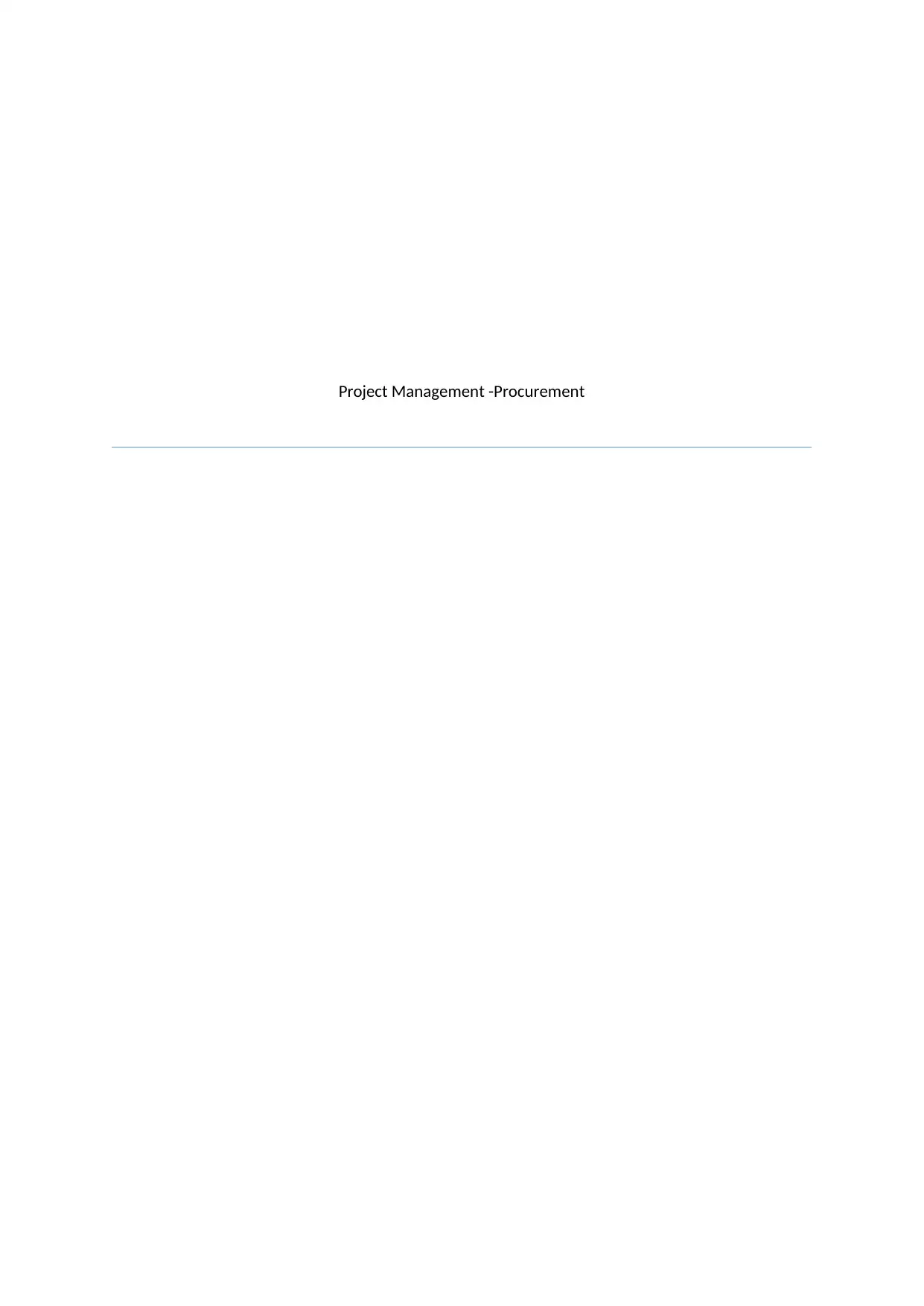
Project Management -Procurement
Secure Best Marks with AI Grader
Need help grading? Try our AI Grader for instant feedback on your assignments.
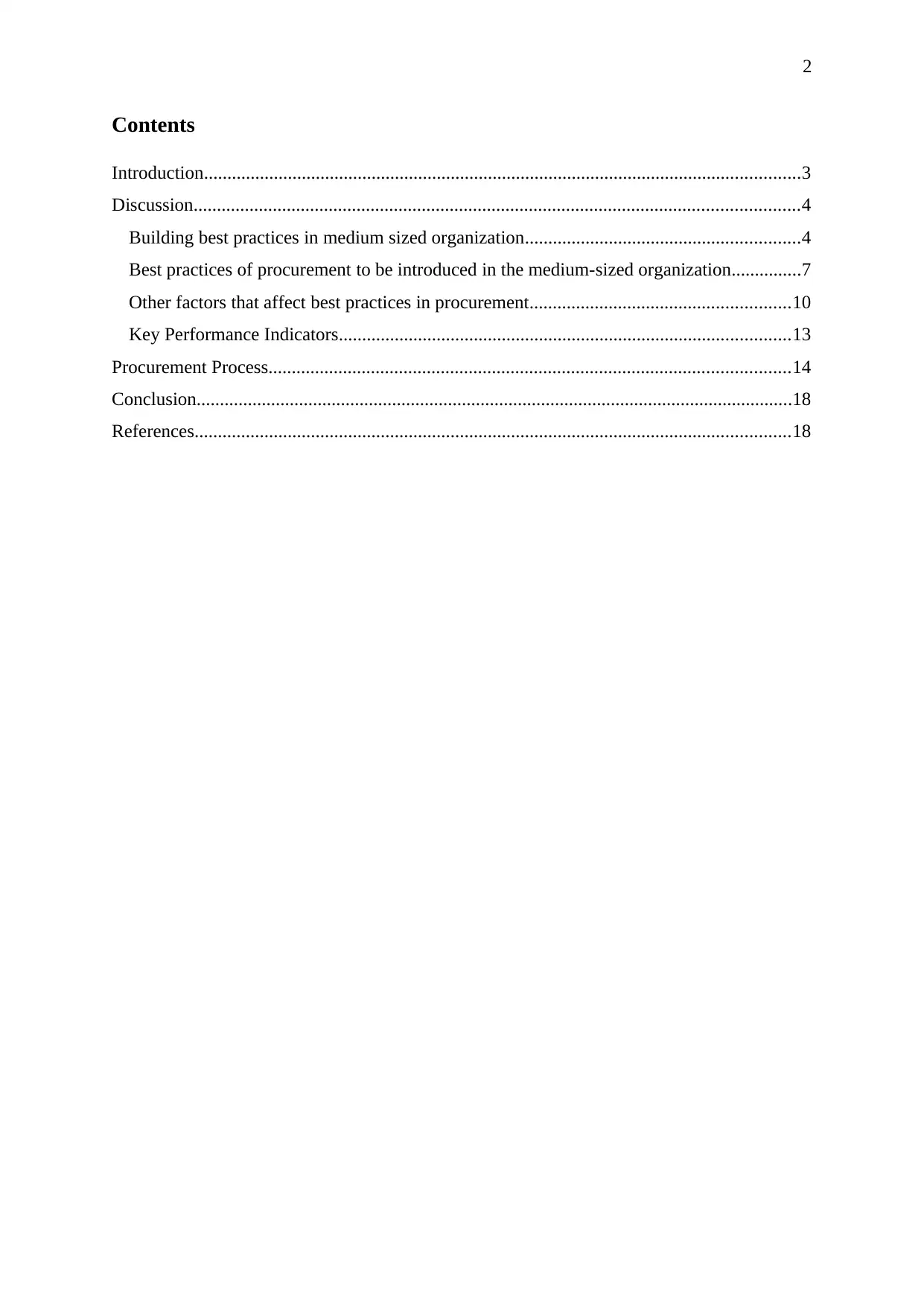
2
Contents
Introduction................................................................................................................................3
Discussion..................................................................................................................................4
Building best practices in medium sized organization...........................................................4
Best practices of procurement to be introduced in the medium-sized organization...............7
Other factors that affect best practices in procurement........................................................10
Key Performance Indicators.................................................................................................13
Procurement Process................................................................................................................14
Conclusion................................................................................................................................18
References................................................................................................................................18
Contents
Introduction................................................................................................................................3
Discussion..................................................................................................................................4
Building best practices in medium sized organization...........................................................4
Best practices of procurement to be introduced in the medium-sized organization...............7
Other factors that affect best practices in procurement........................................................10
Key Performance Indicators.................................................................................................13
Procurement Process................................................................................................................14
Conclusion................................................................................................................................18
References................................................................................................................................18
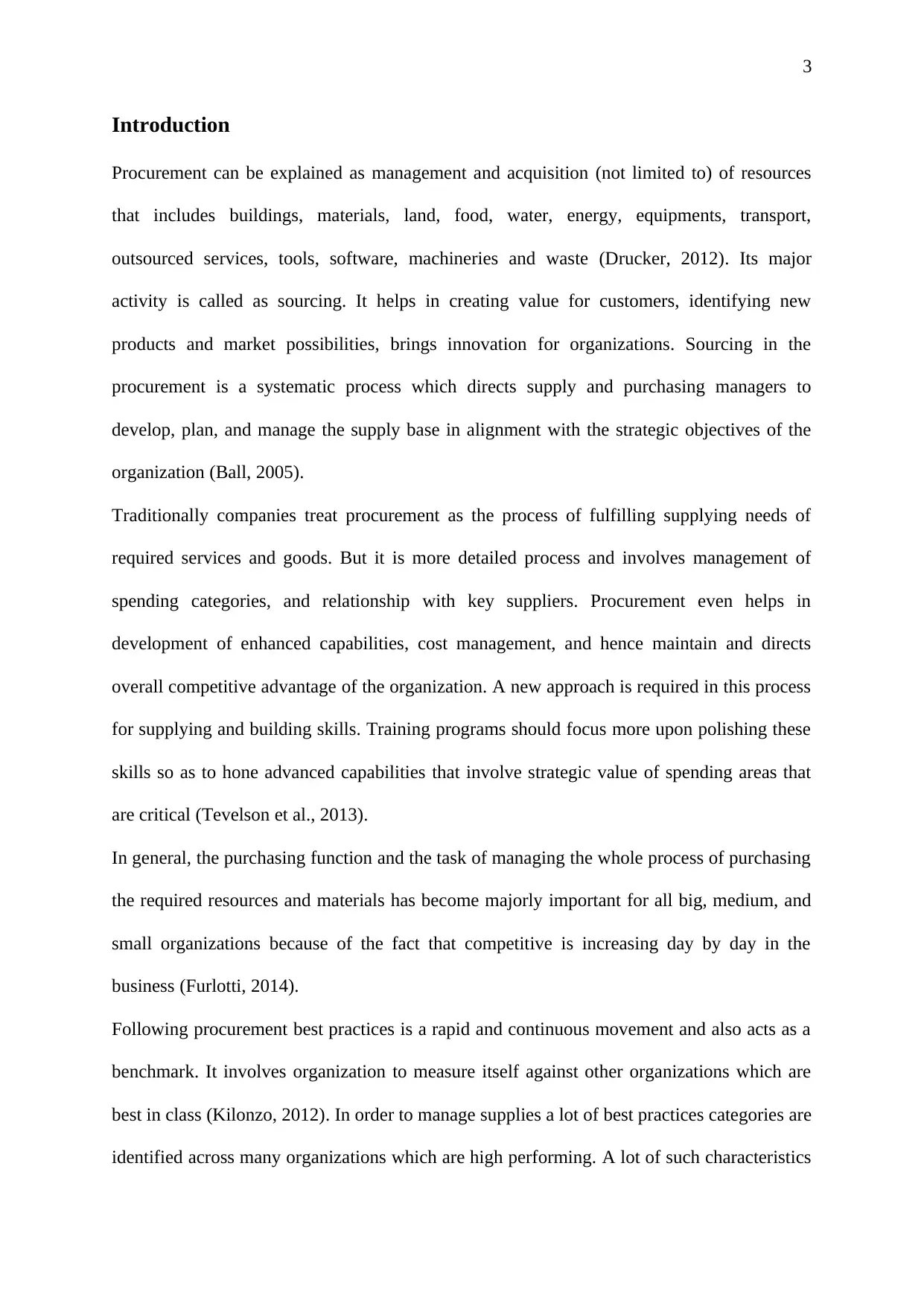
3
Introduction
Procurement can be explained as management and acquisition (not limited to) of resources
that includes buildings, materials, land, food, water, energy, equipments, transport,
outsourced services, tools, software, machineries and waste (Drucker, 2012). Its major
activity is called as sourcing. It helps in creating value for customers, identifying new
products and market possibilities, brings innovation for organizations. Sourcing in the
procurement is a systematic process which directs supply and purchasing managers to
develop, plan, and manage the supply base in alignment with the strategic objectives of the
organization (Ball, 2005).
Traditionally companies treat procurement as the process of fulfilling supplying needs of
required services and goods. But it is more detailed process and involves management of
spending categories, and relationship with key suppliers. Procurement even helps in
development of enhanced capabilities, cost management, and hence maintain and directs
overall competitive advantage of the organization. A new approach is required in this process
for supplying and building skills. Training programs should focus more upon polishing these
skills so as to hone advanced capabilities that involve strategic value of spending areas that
are critical (Tevelson et al., 2013).
In general, the purchasing function and the task of managing the whole process of purchasing
the required resources and materials has become majorly important for all big, medium, and
small organizations because of the fact that competitive is increasing day by day in the
business (Furlotti, 2014).
Following procurement best practices is a rapid and continuous movement and also acts as a
benchmark. It involves organization to measure itself against other organizations which are
best in class (Kilonzo, 2012). In order to manage supplies a lot of best practices categories are
identified across many organizations which are high performing. A lot of such characteristics
Introduction
Procurement can be explained as management and acquisition (not limited to) of resources
that includes buildings, materials, land, food, water, energy, equipments, transport,
outsourced services, tools, software, machineries and waste (Drucker, 2012). Its major
activity is called as sourcing. It helps in creating value for customers, identifying new
products and market possibilities, brings innovation for organizations. Sourcing in the
procurement is a systematic process which directs supply and purchasing managers to
develop, plan, and manage the supply base in alignment with the strategic objectives of the
organization (Ball, 2005).
Traditionally companies treat procurement as the process of fulfilling supplying needs of
required services and goods. But it is more detailed process and involves management of
spending categories, and relationship with key suppliers. Procurement even helps in
development of enhanced capabilities, cost management, and hence maintain and directs
overall competitive advantage of the organization. A new approach is required in this process
for supplying and building skills. Training programs should focus more upon polishing these
skills so as to hone advanced capabilities that involve strategic value of spending areas that
are critical (Tevelson et al., 2013).
In general, the purchasing function and the task of managing the whole process of purchasing
the required resources and materials has become majorly important for all big, medium, and
small organizations because of the fact that competitive is increasing day by day in the
business (Furlotti, 2014).
Following procurement best practices is a rapid and continuous movement and also acts as a
benchmark. It involves organization to measure itself against other organizations which are
best in class (Kilonzo, 2012). In order to manage supplies a lot of best practices categories are
identified across many organizations which are high performing. A lot of such characteristics
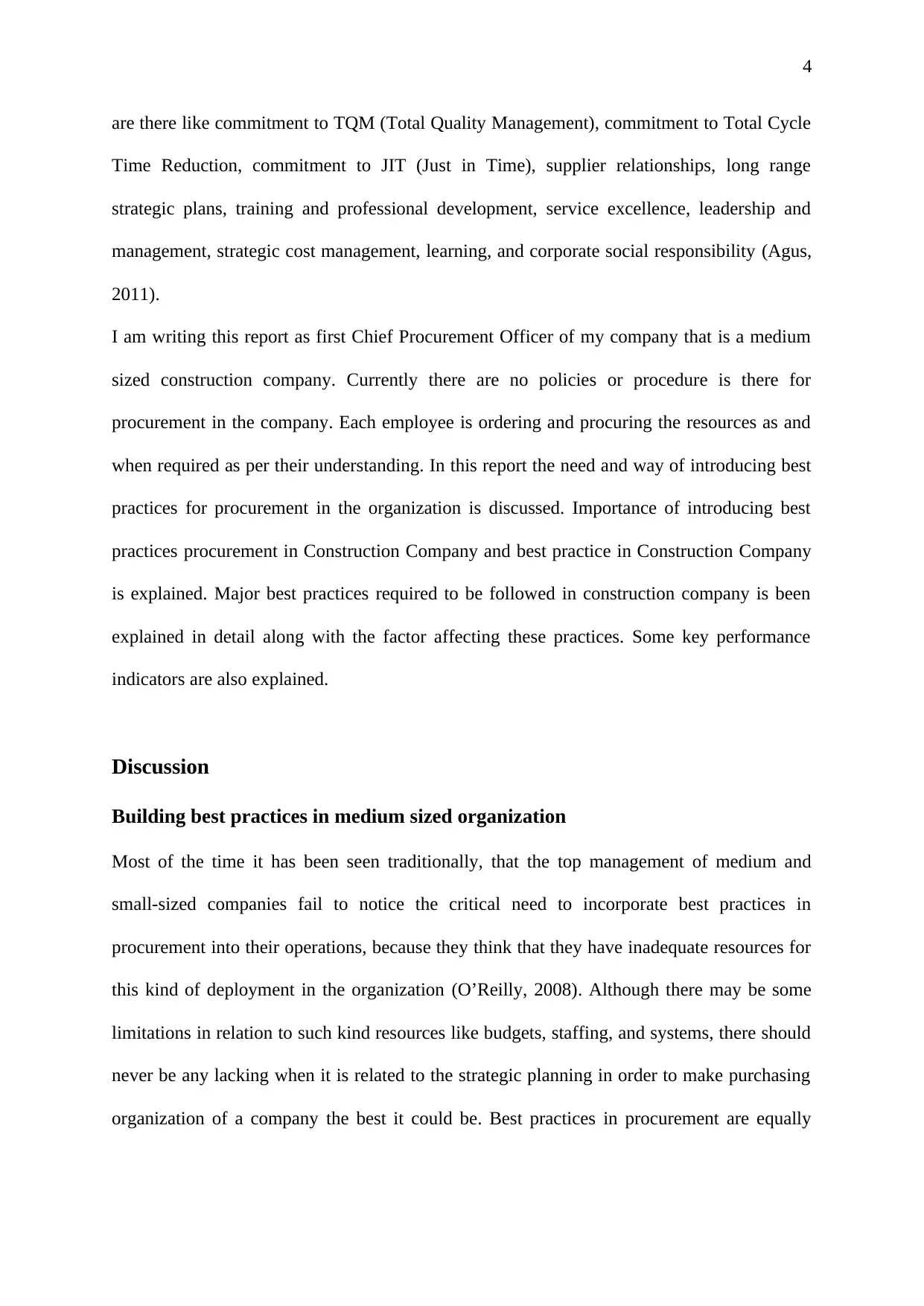
4
are there like commitment to TQM (Total Quality Management), commitment to Total Cycle
Time Reduction, commitment to JIT (Just in Time), supplier relationships, long range
strategic plans, training and professional development, service excellence, leadership and
management, strategic cost management, learning, and corporate social responsibility (Agus,
2011).
I am writing this report as first Chief Procurement Officer of my company that is a medium
sized construction company. Currently there are no policies or procedure is there for
procurement in the company. Each employee is ordering and procuring the resources as and
when required as per their understanding. In this report the need and way of introducing best
practices for procurement in the organization is discussed. Importance of introducing best
practices procurement in Construction Company and best practice in Construction Company
is explained. Major best practices required to be followed in construction company is been
explained in detail along with the factor affecting these practices. Some key performance
indicators are also explained.
Discussion
Building best practices in medium sized organization
Most of the time it has been seen traditionally, that the top management of medium and
small-sized companies fail to notice the critical need to incorporate best practices in
procurement into their operations, because they think that they have inadequate resources for
this kind of deployment in the organization (O’Reilly, 2008). Although there may be some
limitations in relation to such kind resources like budgets, staffing, and systems, there should
never be any lacking when it is related to the strategic planning in order to make purchasing
organization of a company the best it could be. Best practices in procurement are equally
are there like commitment to TQM (Total Quality Management), commitment to Total Cycle
Time Reduction, commitment to JIT (Just in Time), supplier relationships, long range
strategic plans, training and professional development, service excellence, leadership and
management, strategic cost management, learning, and corporate social responsibility (Agus,
2011).
I am writing this report as first Chief Procurement Officer of my company that is a medium
sized construction company. Currently there are no policies or procedure is there for
procurement in the company. Each employee is ordering and procuring the resources as and
when required as per their understanding. In this report the need and way of introducing best
practices for procurement in the organization is discussed. Importance of introducing best
practices procurement in Construction Company and best practice in Construction Company
is explained. Major best practices required to be followed in construction company is been
explained in detail along with the factor affecting these practices. Some key performance
indicators are also explained.
Discussion
Building best practices in medium sized organization
Most of the time it has been seen traditionally, that the top management of medium and
small-sized companies fail to notice the critical need to incorporate best practices in
procurement into their operations, because they think that they have inadequate resources for
this kind of deployment in the organization (O’Reilly, 2008). Although there may be some
limitations in relation to such kind resources like budgets, staffing, and systems, there should
never be any lacking when it is related to the strategic planning in order to make purchasing
organization of a company the best it could be. Best practices in procurement are equally
Secure Best Marks with AI Grader
Need help grading? Try our AI Grader for instant feedback on your assignments.
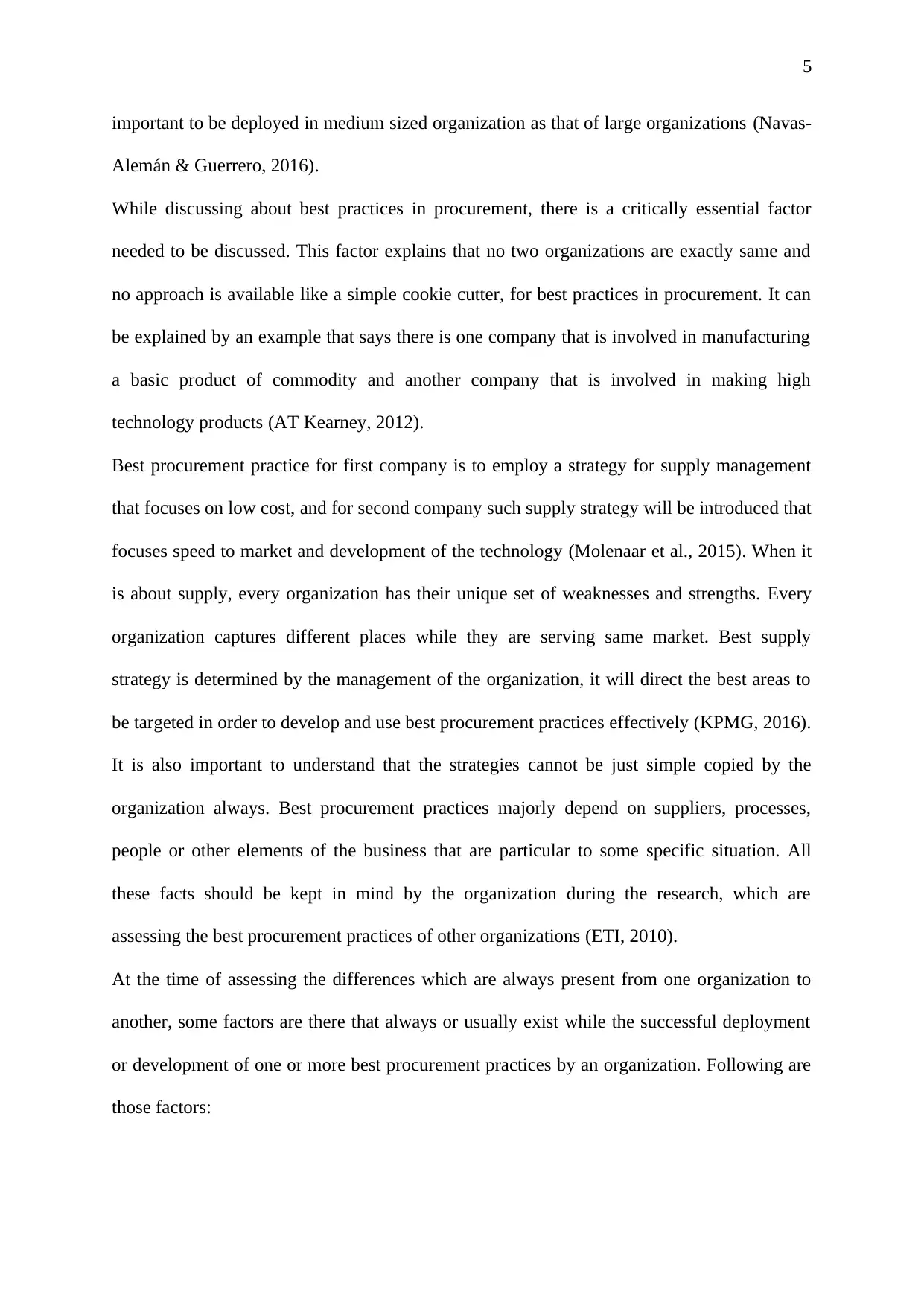
5
important to be deployed in medium sized organization as that of large organizations (Navas-
Alemán & Guerrero, 2016).
While discussing about best practices in procurement, there is a critically essential factor
needed to be discussed. This factor explains that no two organizations are exactly same and
no approach is available like a simple cookie cutter, for best practices in procurement. It can
be explained by an example that says there is one company that is involved in manufacturing
a basic product of commodity and another company that is involved in making high
technology products (AT Kearney, 2012).
Best procurement practice for first company is to employ a strategy for supply management
that focuses on low cost, and for second company such supply strategy will be introduced that
focuses speed to market and development of the technology (Molenaar et al., 2015). When it
is about supply, every organization has their unique set of weaknesses and strengths. Every
organization captures different places while they are serving same market. Best supply
strategy is determined by the management of the organization, it will direct the best areas to
be targeted in order to develop and use best procurement practices effectively (KPMG, 2016).
It is also important to understand that the strategies cannot be just simple copied by the
organization always. Best procurement practices majorly depend on suppliers, processes,
people or other elements of the business that are particular to some specific situation. All
these facts should be kept in mind by the organization during the research, which are
assessing the best procurement practices of other organizations (ETI, 2010).
At the time of assessing the differences which are always present from one organization to
another, some factors are there that always or usually exist while the successful deployment
or development of one or more best procurement practices by an organization. Following are
those factors:
important to be deployed in medium sized organization as that of large organizations (Navas-
Alemán & Guerrero, 2016).
While discussing about best practices in procurement, there is a critically essential factor
needed to be discussed. This factor explains that no two organizations are exactly same and
no approach is available like a simple cookie cutter, for best practices in procurement. It can
be explained by an example that says there is one company that is involved in manufacturing
a basic product of commodity and another company that is involved in making high
technology products (AT Kearney, 2012).
Best procurement practice for first company is to employ a strategy for supply management
that focuses on low cost, and for second company such supply strategy will be introduced that
focuses speed to market and development of the technology (Molenaar et al., 2015). When it
is about supply, every organization has their unique set of weaknesses and strengths. Every
organization captures different places while they are serving same market. Best supply
strategy is determined by the management of the organization, it will direct the best areas to
be targeted in order to develop and use best procurement practices effectively (KPMG, 2016).
It is also important to understand that the strategies cannot be just simple copied by the
organization always. Best procurement practices majorly depend on suppliers, processes,
people or other elements of the business that are particular to some specific situation. All
these facts should be kept in mind by the organization during the research, which are
assessing the best procurement practices of other organizations (ETI, 2010).
At the time of assessing the differences which are always present from one organization to
another, some factors are there that always or usually exist while the successful deployment
or development of one or more best procurement practices by an organization. Following are
those factors:
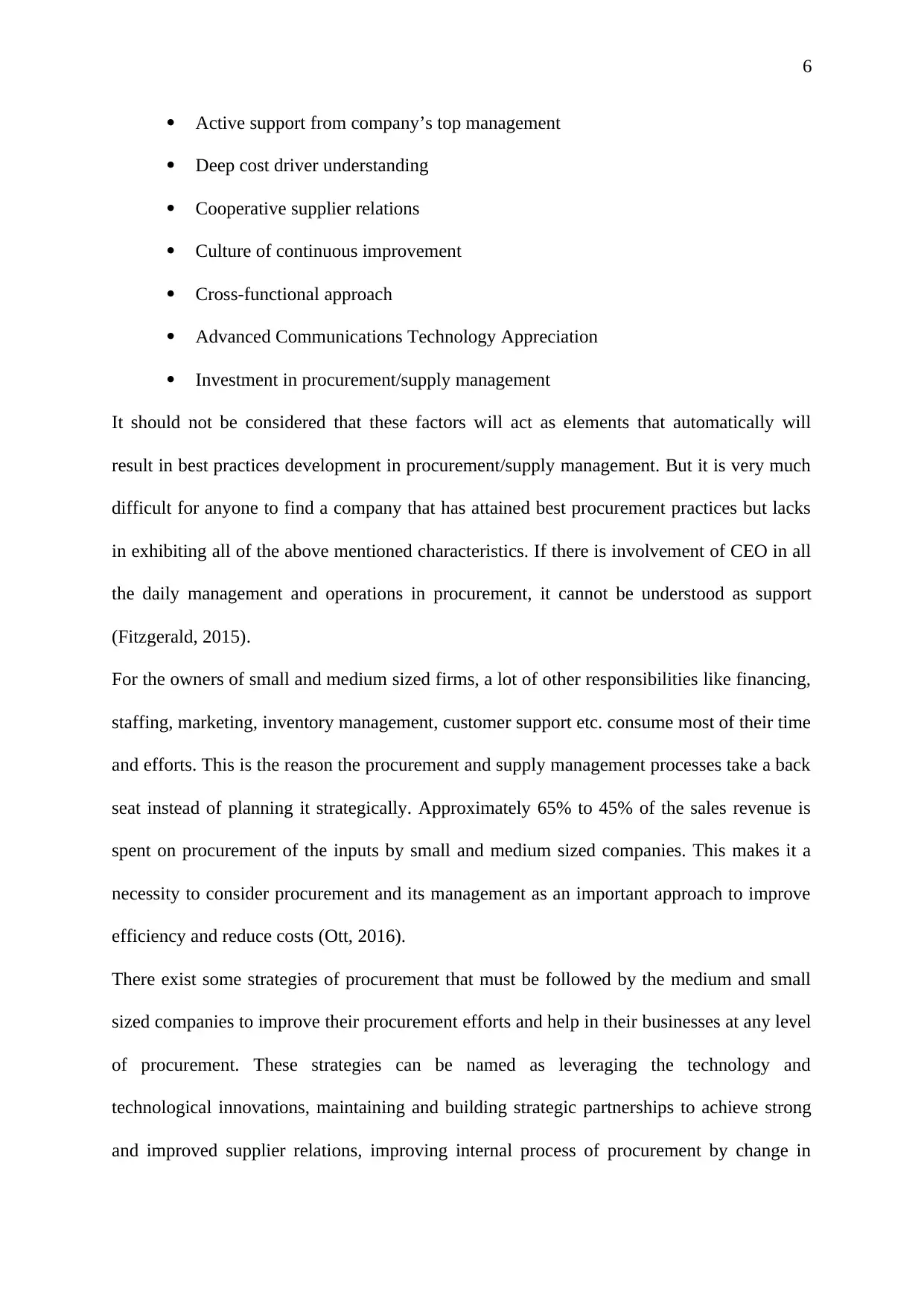
6
Active support from company’s top management
Deep cost driver understanding
Cooperative supplier relations
Culture of continuous improvement
Cross-functional approach
Advanced Communications Technology Appreciation
Investment in procurement/supply management
It should not be considered that these factors will act as elements that automatically will
result in best practices development in procurement/supply management. But it is very much
difficult for anyone to find a company that has attained best procurement practices but lacks
in exhibiting all of the above mentioned characteristics. If there is involvement of CEO in all
the daily management and operations in procurement, it cannot be understood as support
(Fitzgerald, 2015).
For the owners of small and medium sized firms, a lot of other responsibilities like financing,
staffing, marketing, inventory management, customer support etc. consume most of their time
and efforts. This is the reason the procurement and supply management processes take a back
seat instead of planning it strategically. Approximately 65% to 45% of the sales revenue is
spent on procurement of the inputs by small and medium sized companies. This makes it a
necessity to consider procurement and its management as an important approach to improve
efficiency and reduce costs (Ott, 2016).
There exist some strategies of procurement that must be followed by the medium and small
sized companies to improve their procurement efforts and help in their businesses at any level
of procurement. These strategies can be named as leveraging the technology and
technological innovations, maintaining and building strategic partnerships to achieve strong
and improved supplier relations, improving internal process of procurement by change in
Active support from company’s top management
Deep cost driver understanding
Cooperative supplier relations
Culture of continuous improvement
Cross-functional approach
Advanced Communications Technology Appreciation
Investment in procurement/supply management
It should not be considered that these factors will act as elements that automatically will
result in best practices development in procurement/supply management. But it is very much
difficult for anyone to find a company that has attained best procurement practices but lacks
in exhibiting all of the above mentioned characteristics. If there is involvement of CEO in all
the daily management and operations in procurement, it cannot be understood as support
(Fitzgerald, 2015).
For the owners of small and medium sized firms, a lot of other responsibilities like financing,
staffing, marketing, inventory management, customer support etc. consume most of their time
and efforts. This is the reason the procurement and supply management processes take a back
seat instead of planning it strategically. Approximately 65% to 45% of the sales revenue is
spent on procurement of the inputs by small and medium sized companies. This makes it a
necessity to consider procurement and its management as an important approach to improve
efficiency and reduce costs (Ott, 2016).
There exist some strategies of procurement that must be followed by the medium and small
sized companies to improve their procurement efforts and help in their businesses at any level
of procurement. These strategies can be named as leveraging the technology and
technological innovations, maintaining and building strategic partnerships to achieve strong
and improved supplier relations, improving internal process of procurement by change in
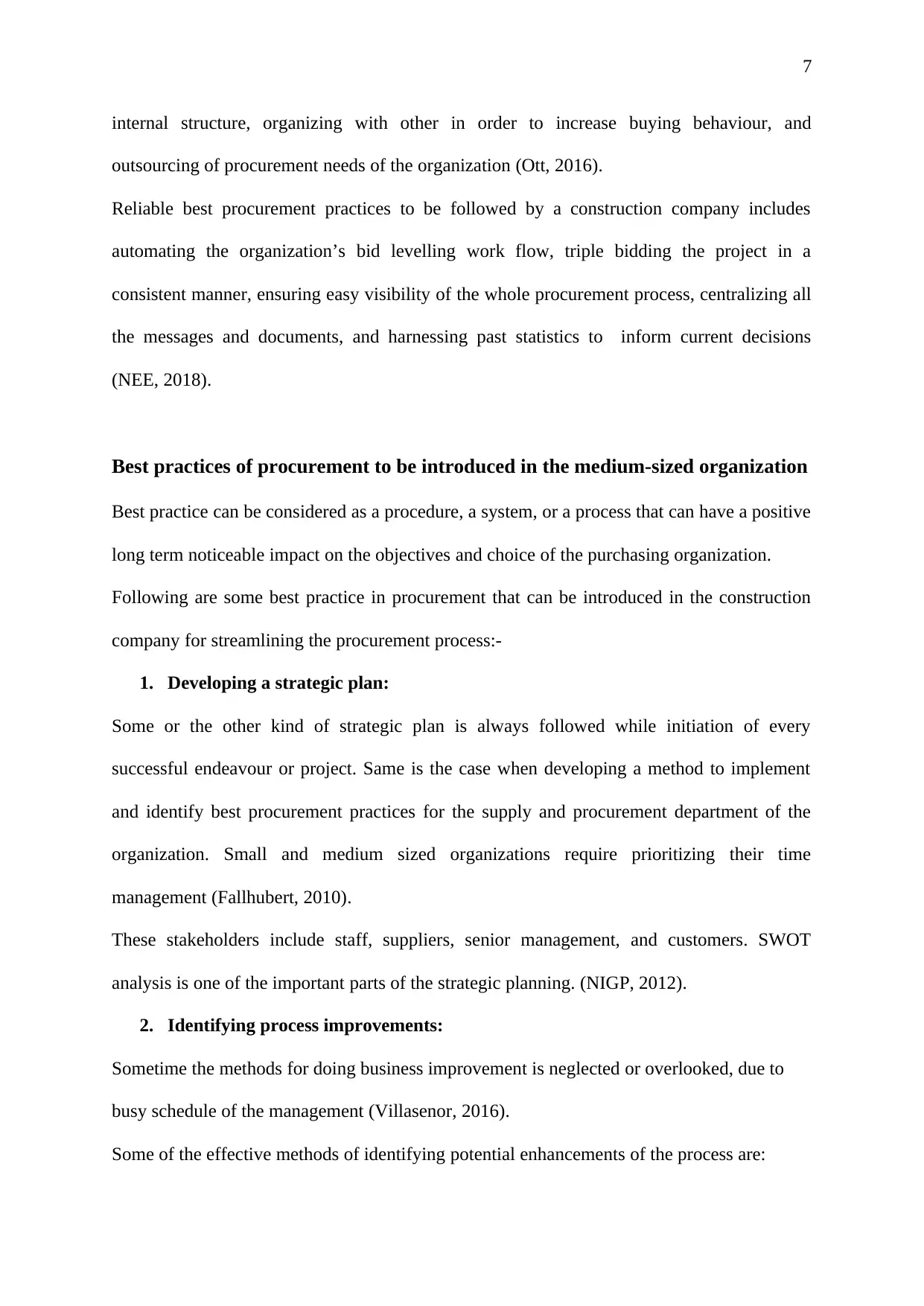
7
internal structure, organizing with other in order to increase buying behaviour, and
outsourcing of procurement needs of the organization (Ott, 2016).
Reliable best procurement practices to be followed by a construction company includes
automating the organization’s bid levelling work flow, triple bidding the project in a
consistent manner, ensuring easy visibility of the whole procurement process, centralizing all
the messages and documents, and harnessing past statistics to inform current decisions
(NEE, 2018).
Best practices of procurement to be introduced in the medium-sized organization
Best practice can be considered as a procedure, a system, or a process that can have a positive
long term noticeable impact on the objectives and choice of the purchasing organization.
Following are some best practice in procurement that can be introduced in the construction
company for streamlining the procurement process:-
1. Developing a strategic plan:
Some or the other kind of strategic plan is always followed while initiation of every
successful endeavour or project. Same is the case when developing a method to implement
and identify best procurement practices for the supply and procurement department of the
organization. Small and medium sized organizations require prioritizing their time
management (Fallhubert, 2010).
These stakeholders include staff, suppliers, senior management, and customers. SWOT
analysis is one of the important parts of the strategic planning. (NIGP, 2012).
2. Identifying process improvements:
Sometime the methods for doing business improvement is neglected or overlooked, due to
busy schedule of the management (Villasenor, 2016).
Some of the effective methods of identifying potential enhancements of the process are:
internal structure, organizing with other in order to increase buying behaviour, and
outsourcing of procurement needs of the organization (Ott, 2016).
Reliable best procurement practices to be followed by a construction company includes
automating the organization’s bid levelling work flow, triple bidding the project in a
consistent manner, ensuring easy visibility of the whole procurement process, centralizing all
the messages and documents, and harnessing past statistics to inform current decisions
(NEE, 2018).
Best practices of procurement to be introduced in the medium-sized organization
Best practice can be considered as a procedure, a system, or a process that can have a positive
long term noticeable impact on the objectives and choice of the purchasing organization.
Following are some best practice in procurement that can be introduced in the construction
company for streamlining the procurement process:-
1. Developing a strategic plan:
Some or the other kind of strategic plan is always followed while initiation of every
successful endeavour or project. Same is the case when developing a method to implement
and identify best procurement practices for the supply and procurement department of the
organization. Small and medium sized organizations require prioritizing their time
management (Fallhubert, 2010).
These stakeholders include staff, suppliers, senior management, and customers. SWOT
analysis is one of the important parts of the strategic planning. (NIGP, 2012).
2. Identifying process improvements:
Sometime the methods for doing business improvement is neglected or overlooked, due to
busy schedule of the management (Villasenor, 2016).
Some of the effective methods of identifying potential enhancements of the process are:
Paraphrase This Document
Need a fresh take? Get an instant paraphrase of this document with our AI Paraphraser
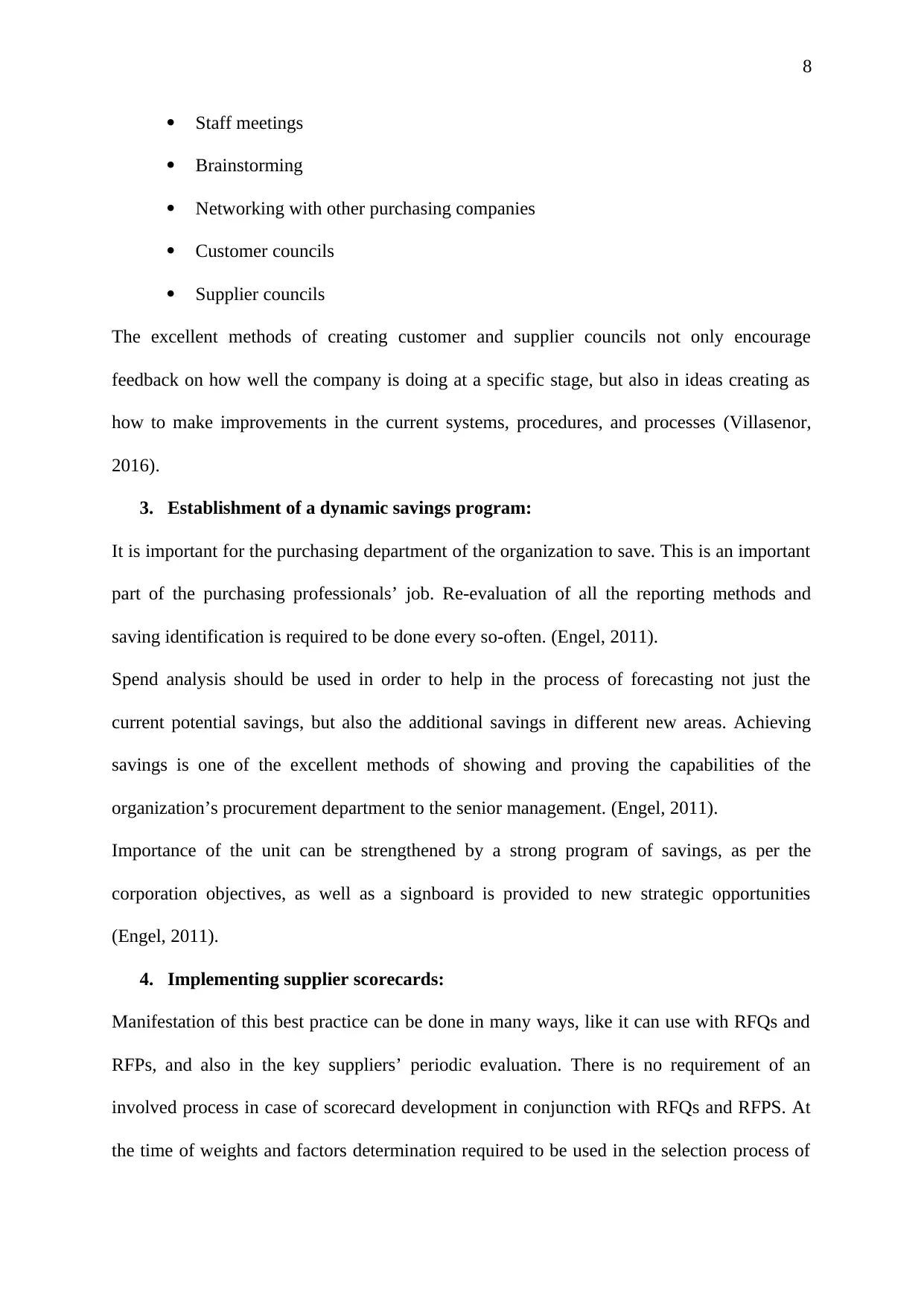
8
Staff meetings
Brainstorming
Networking with other purchasing companies
Customer councils
Supplier councils
The excellent methods of creating customer and supplier councils not only encourage
feedback on how well the company is doing at a specific stage, but also in ideas creating as
how to make improvements in the current systems, procedures, and processes (Villasenor,
2016).
3. Establishment of a dynamic savings program:
It is important for the purchasing department of the organization to save. This is an important
part of the purchasing professionals’ job. Re-evaluation of all the reporting methods and
saving identification is required to be done every so-often. (Engel, 2011).
Spend analysis should be used in order to help in the process of forecasting not just the
current potential savings, but also the additional savings in different new areas. Achieving
savings is one of the excellent methods of showing and proving the capabilities of the
organization’s procurement department to the senior management. (Engel, 2011).
Importance of the unit can be strengthened by a strong program of savings, as per the
corporation objectives, as well as a signboard is provided to new strategic opportunities
(Engel, 2011).
4. Implementing supplier scorecards:
Manifestation of this best practice can be done in many ways, like it can use with RFQs and
RFPs, and also in the key suppliers’ periodic evaluation. There is no requirement of an
involved process in case of scorecard development in conjunction with RFQs and RFPS. At
the time of weights and factors determination required to be used in the selection process of
Staff meetings
Brainstorming
Networking with other purchasing companies
Customer councils
Supplier councils
The excellent methods of creating customer and supplier councils not only encourage
feedback on how well the company is doing at a specific stage, but also in ideas creating as
how to make improvements in the current systems, procedures, and processes (Villasenor,
2016).
3. Establishment of a dynamic savings program:
It is important for the purchasing department of the organization to save. This is an important
part of the purchasing professionals’ job. Re-evaluation of all the reporting methods and
saving identification is required to be done every so-often. (Engel, 2011).
Spend analysis should be used in order to help in the process of forecasting not just the
current potential savings, but also the additional savings in different new areas. Achieving
savings is one of the excellent methods of showing and proving the capabilities of the
organization’s procurement department to the senior management. (Engel, 2011).
Importance of the unit can be strengthened by a strong program of savings, as per the
corporation objectives, as well as a signboard is provided to new strategic opportunities
(Engel, 2011).
4. Implementing supplier scorecards:
Manifestation of this best practice can be done in many ways, like it can use with RFQs and
RFPs, and also in the key suppliers’ periodic evaluation. There is no requirement of an
involved process in case of scorecard development in conjunction with RFQs and RFPS. At
the time of weights and factors determination required to be used in the selection process of
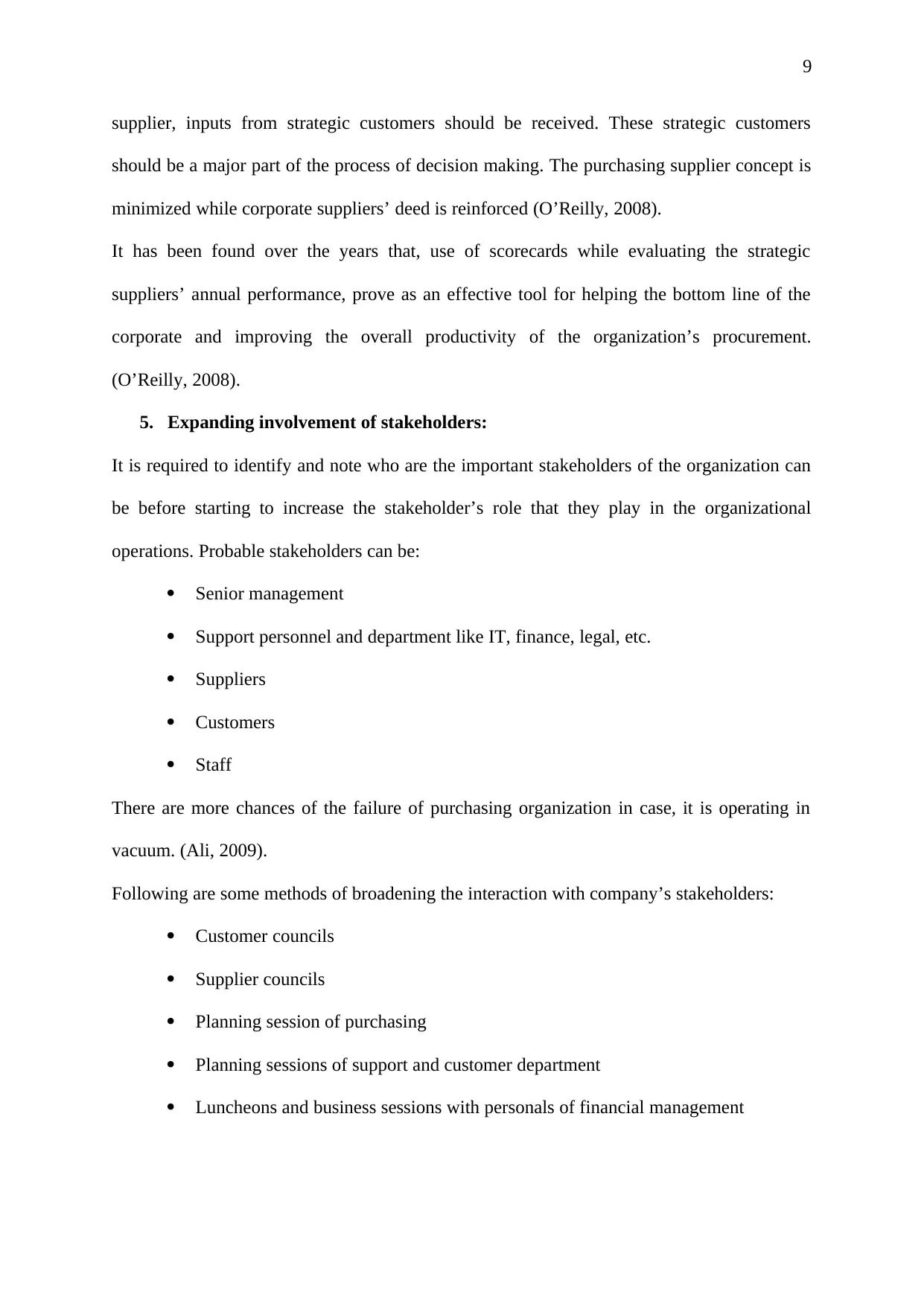
9
supplier, inputs from strategic customers should be received. These strategic customers
should be a major part of the process of decision making. The purchasing supplier concept is
minimized while corporate suppliers’ deed is reinforced (O’Reilly, 2008).
It has been found over the years that, use of scorecards while evaluating the strategic
suppliers’ annual performance, prove as an effective tool for helping the bottom line of the
corporate and improving the overall productivity of the organization’s procurement.
(O’Reilly, 2008).
5. Expanding involvement of stakeholders:
It is required to identify and note who are the important stakeholders of the organization can
be before starting to increase the stakeholder’s role that they play in the organizational
operations. Probable stakeholders can be:
Senior management
Support personnel and department like IT, finance, legal, etc.
Suppliers
Customers
Staff
There are more chances of the failure of purchasing organization in case, it is operating in
vacuum. (Ali, 2009).
Following are some methods of broadening the interaction with company’s stakeholders:
Customer councils
Supplier councils
Planning session of purchasing
Planning sessions of support and customer department
Luncheons and business sessions with personals of financial management
supplier, inputs from strategic customers should be received. These strategic customers
should be a major part of the process of decision making. The purchasing supplier concept is
minimized while corporate suppliers’ deed is reinforced (O’Reilly, 2008).
It has been found over the years that, use of scorecards while evaluating the strategic
suppliers’ annual performance, prove as an effective tool for helping the bottom line of the
corporate and improving the overall productivity of the organization’s procurement.
(O’Reilly, 2008).
5. Expanding involvement of stakeholders:
It is required to identify and note who are the important stakeholders of the organization can
be before starting to increase the stakeholder’s role that they play in the organizational
operations. Probable stakeholders can be:
Senior management
Support personnel and department like IT, finance, legal, etc.
Suppliers
Customers
Staff
There are more chances of the failure of purchasing organization in case, it is operating in
vacuum. (Ali, 2009).
Following are some methods of broadening the interaction with company’s stakeholders:
Customer councils
Supplier councils
Planning session of purchasing
Planning sessions of support and customer department
Luncheons and business sessions with personals of financial management
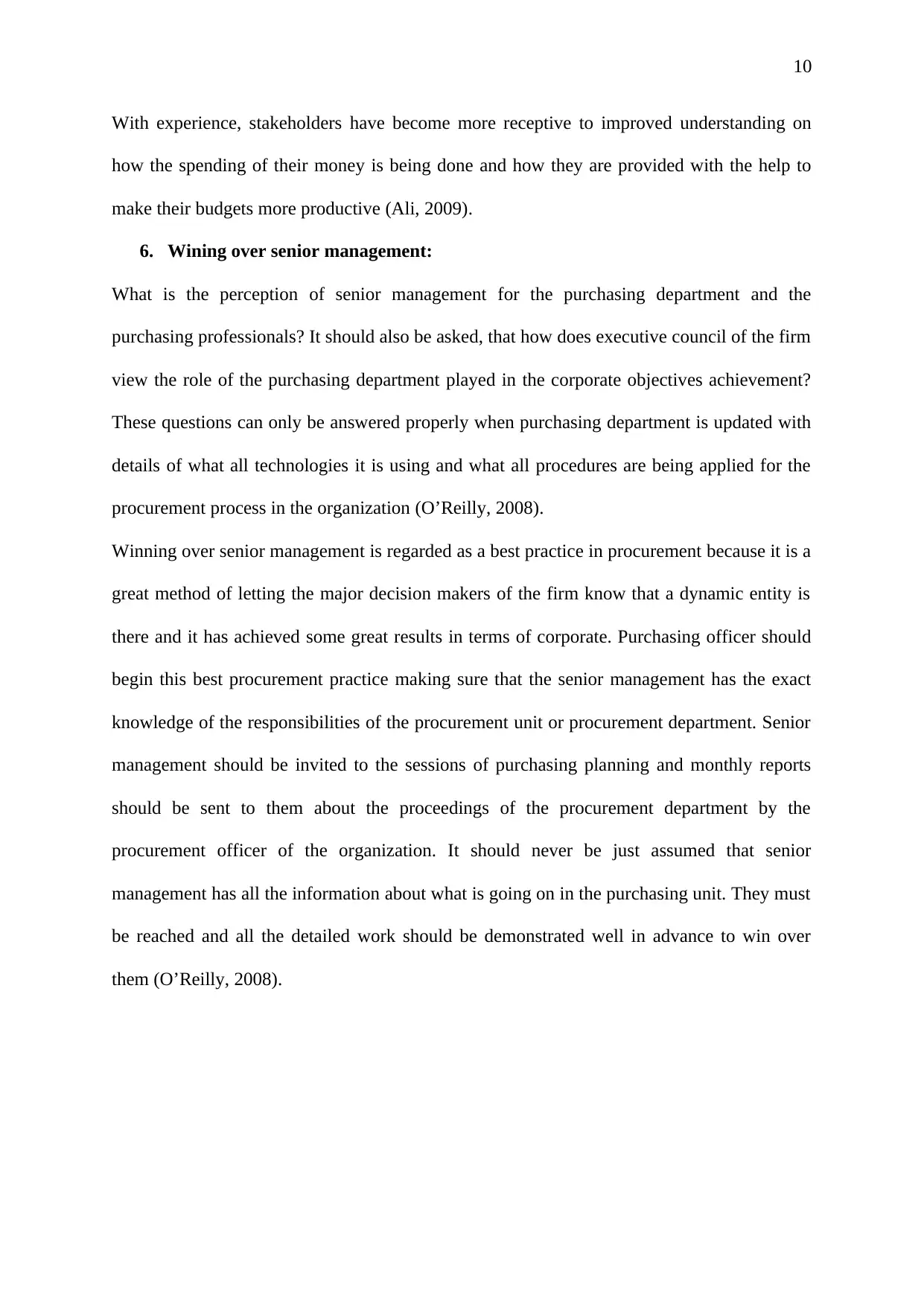
10
With experience, stakeholders have become more receptive to improved understanding on
how the spending of their money is being done and how they are provided with the help to
make their budgets more productive (Ali, 2009).
6. Wining over senior management:
What is the perception of senior management for the purchasing department and the
purchasing professionals? It should also be asked, that how does executive council of the firm
view the role of the purchasing department played in the corporate objectives achievement?
These questions can only be answered properly when purchasing department is updated with
details of what all technologies it is using and what all procedures are being applied for the
procurement process in the organization (O’Reilly, 2008).
Winning over senior management is regarded as a best practice in procurement because it is a
great method of letting the major decision makers of the firm know that a dynamic entity is
there and it has achieved some great results in terms of corporate. Purchasing officer should
begin this best procurement practice making sure that the senior management has the exact
knowledge of the responsibilities of the procurement unit or procurement department. Senior
management should be invited to the sessions of purchasing planning and monthly reports
should be sent to them about the proceedings of the procurement department by the
procurement officer of the organization. It should never be just assumed that senior
management has all the information about what is going on in the purchasing unit. They must
be reached and all the detailed work should be demonstrated well in advance to win over
them (O’Reilly, 2008).
With experience, stakeholders have become more receptive to improved understanding on
how the spending of their money is being done and how they are provided with the help to
make their budgets more productive (Ali, 2009).
6. Wining over senior management:
What is the perception of senior management for the purchasing department and the
purchasing professionals? It should also be asked, that how does executive council of the firm
view the role of the purchasing department played in the corporate objectives achievement?
These questions can only be answered properly when purchasing department is updated with
details of what all technologies it is using and what all procedures are being applied for the
procurement process in the organization (O’Reilly, 2008).
Winning over senior management is regarded as a best practice in procurement because it is a
great method of letting the major decision makers of the firm know that a dynamic entity is
there and it has achieved some great results in terms of corporate. Purchasing officer should
begin this best procurement practice making sure that the senior management has the exact
knowledge of the responsibilities of the procurement unit or procurement department. Senior
management should be invited to the sessions of purchasing planning and monthly reports
should be sent to them about the proceedings of the procurement department by the
procurement officer of the organization. It should never be just assumed that senior
management has all the information about what is going on in the purchasing unit. They must
be reached and all the detailed work should be demonstrated well in advance to win over
them (O’Reilly, 2008).
Secure Best Marks with AI Grader
Need help grading? Try our AI Grader for instant feedback on your assignments.
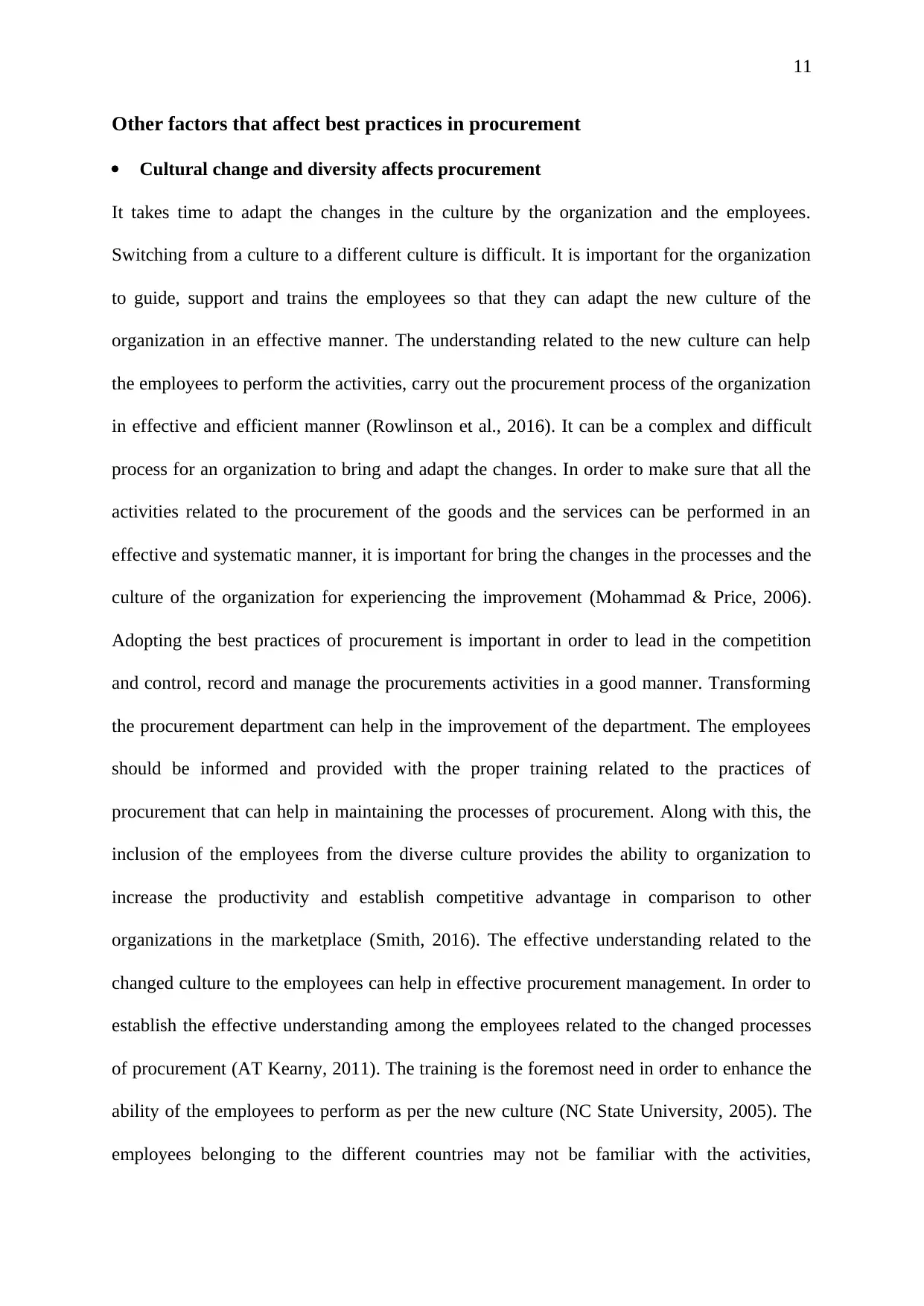
11
Other factors that affect best practices in procurement
Cultural change and diversity affects procurement
It takes time to adapt the changes in the culture by the organization and the employees.
Switching from a culture to a different culture is difficult. It is important for the organization
to guide, support and trains the employees so that they can adapt the new culture of the
organization in an effective manner. The understanding related to the new culture can help
the employees to perform the activities, carry out the procurement process of the organization
in effective and efficient manner (Rowlinson et al., 2016). It can be a complex and difficult
process for an organization to bring and adapt the changes. In order to make sure that all the
activities related to the procurement of the goods and the services can be performed in an
effective and systematic manner, it is important for bring the changes in the processes and the
culture of the organization for experiencing the improvement (Mohammad & Price, 2006).
Adopting the best practices of procurement is important in order to lead in the competition
and control, record and manage the procurements activities in a good manner. Transforming
the procurement department can help in the improvement of the department. The employees
should be informed and provided with the proper training related to the practices of
procurement that can help in maintaining the processes of procurement. Along with this, the
inclusion of the employees from the diverse culture provides the ability to organization to
increase the productivity and establish competitive advantage in comparison to other
organizations in the marketplace (Smith, 2016). The effective understanding related to the
changed culture to the employees can help in effective procurement management. In order to
establish the effective understanding among the employees related to the changed processes
of procurement (AT Kearny, 2011). The training is the foremost need in order to enhance the
ability of the employees to perform as per the new culture (NC State University, 2005). The
employees belonging to the different countries may not be familiar with the activities,
Other factors that affect best practices in procurement
Cultural change and diversity affects procurement
It takes time to adapt the changes in the culture by the organization and the employees.
Switching from a culture to a different culture is difficult. It is important for the organization
to guide, support and trains the employees so that they can adapt the new culture of the
organization in an effective manner. The understanding related to the new culture can help
the employees to perform the activities, carry out the procurement process of the organization
in effective and efficient manner (Rowlinson et al., 2016). It can be a complex and difficult
process for an organization to bring and adapt the changes. In order to make sure that all the
activities related to the procurement of the goods and the services can be performed in an
effective and systematic manner, it is important for bring the changes in the processes and the
culture of the organization for experiencing the improvement (Mohammad & Price, 2006).
Adopting the best practices of procurement is important in order to lead in the competition
and control, record and manage the procurements activities in a good manner. Transforming
the procurement department can help in the improvement of the department. The employees
should be informed and provided with the proper training related to the practices of
procurement that can help in maintaining the processes of procurement. Along with this, the
inclusion of the employees from the diverse culture provides the ability to organization to
increase the productivity and establish competitive advantage in comparison to other
organizations in the marketplace (Smith, 2016). The effective understanding related to the
changed culture to the employees can help in effective procurement management. In order to
establish the effective understanding among the employees related to the changed processes
of procurement (AT Kearny, 2011). The training is the foremost need in order to enhance the
ability of the employees to perform as per the new culture (NC State University, 2005). The
employees belonging to the different countries may not be familiar with the activities,
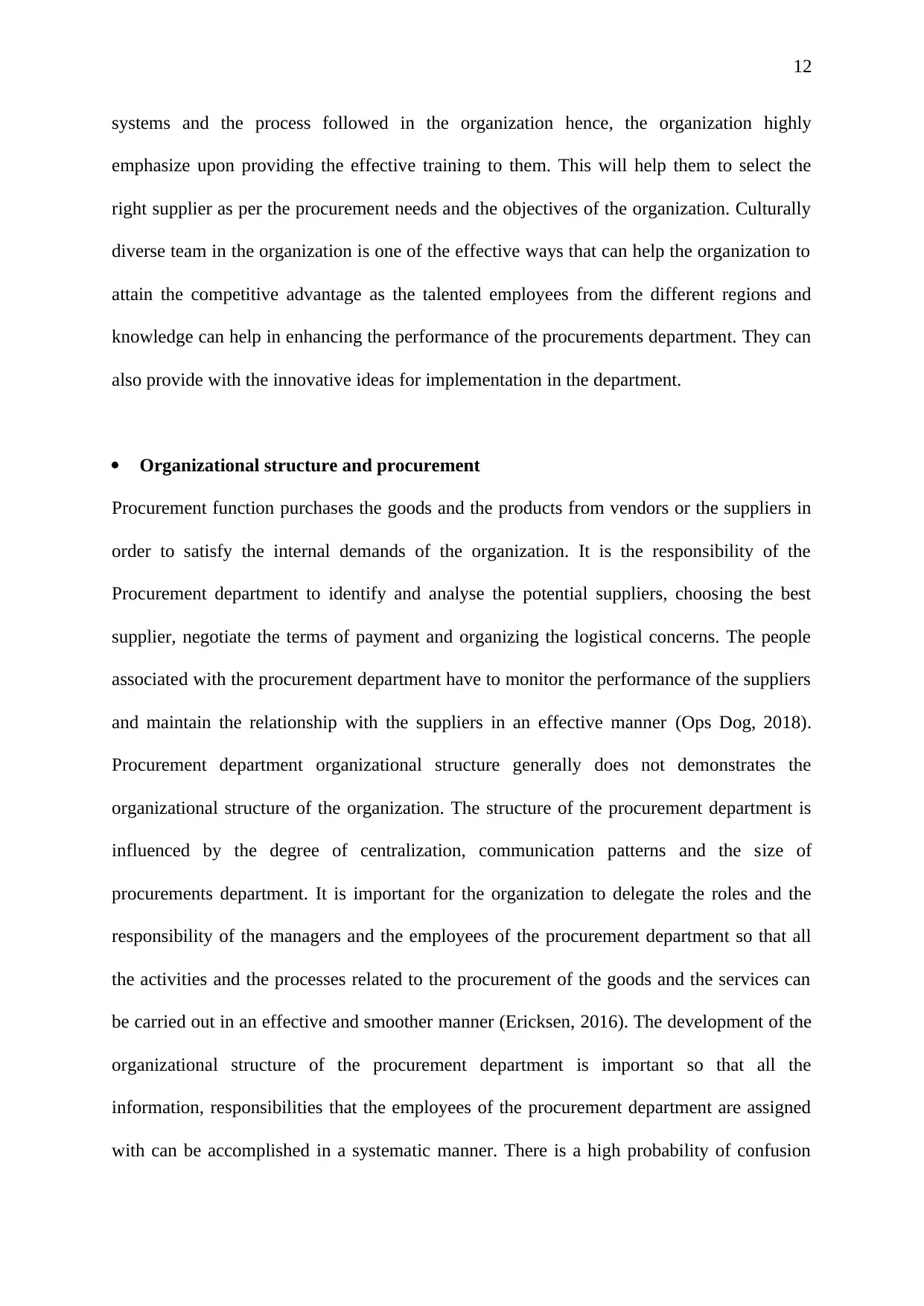
12
systems and the process followed in the organization hence, the organization highly
emphasize upon providing the effective training to them. This will help them to select the
right supplier as per the procurement needs and the objectives of the organization. Culturally
diverse team in the organization is one of the effective ways that can help the organization to
attain the competitive advantage as the talented employees from the different regions and
knowledge can help in enhancing the performance of the procurements department. They can
also provide with the innovative ideas for implementation in the department.
Organizational structure and procurement
Procurement function purchases the goods and the products from vendors or the suppliers in
order to satisfy the internal demands of the organization. It is the responsibility of the
Procurement department to identify and analyse the potential suppliers, choosing the best
supplier, negotiate the terms of payment and organizing the logistical concerns. The people
associated with the procurement department have to monitor the performance of the suppliers
and maintain the relationship with the suppliers in an effective manner (Ops Dog, 2018).
Procurement department organizational structure generally does not demonstrates the
organizational structure of the organization. The structure of the procurement department is
influenced by the degree of centralization, communication patterns and the size of
procurements department. It is important for the organization to delegate the roles and the
responsibility of the managers and the employees of the procurement department so that all
the activities and the processes related to the procurement of the goods and the services can
be carried out in an effective and smoother manner (Ericksen, 2016). The development of the
organizational structure of the procurement department is important so that all the
information, responsibilities that the employees of the procurement department are assigned
with can be accomplished in a systematic manner. There is a high probability of confusion
systems and the process followed in the organization hence, the organization highly
emphasize upon providing the effective training to them. This will help them to select the
right supplier as per the procurement needs and the objectives of the organization. Culturally
diverse team in the organization is one of the effective ways that can help the organization to
attain the competitive advantage as the talented employees from the different regions and
knowledge can help in enhancing the performance of the procurements department. They can
also provide with the innovative ideas for implementation in the department.
Organizational structure and procurement
Procurement function purchases the goods and the products from vendors or the suppliers in
order to satisfy the internal demands of the organization. It is the responsibility of the
Procurement department to identify and analyse the potential suppliers, choosing the best
supplier, negotiate the terms of payment and organizing the logistical concerns. The people
associated with the procurement department have to monitor the performance of the suppliers
and maintain the relationship with the suppliers in an effective manner (Ops Dog, 2018).
Procurement department organizational structure generally does not demonstrates the
organizational structure of the organization. The structure of the procurement department is
influenced by the degree of centralization, communication patterns and the size of
procurements department. It is important for the organization to delegate the roles and the
responsibility of the managers and the employees of the procurement department so that all
the activities and the processes related to the procurement of the goods and the services can
be carried out in an effective and smoother manner (Ericksen, 2016). The development of the
organizational structure of the procurement department is important so that all the
information, responsibilities that the employees of the procurement department are assigned
with can be accomplished in a systematic manner. There is a high probability of confusion
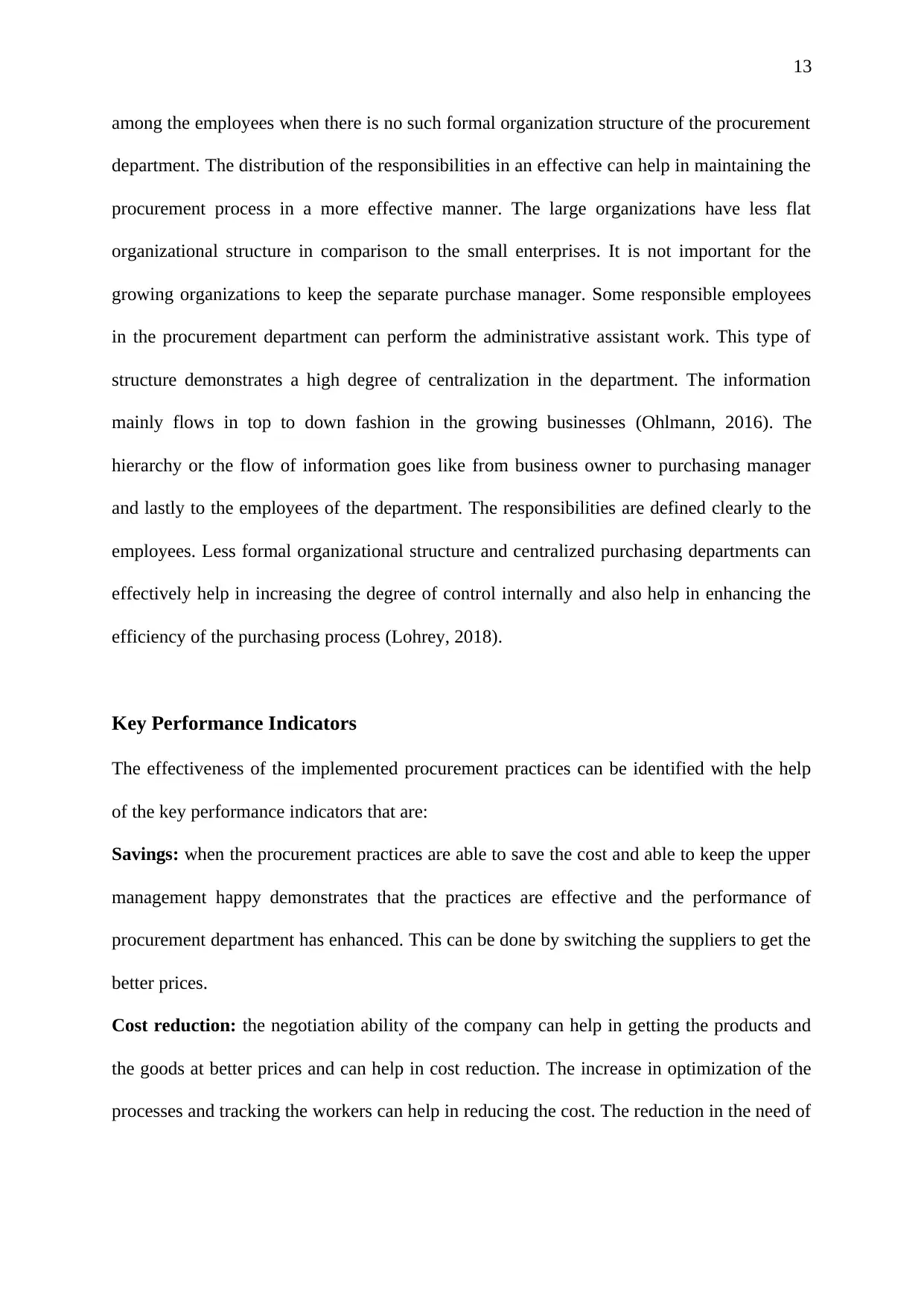
13
among the employees when there is no such formal organization structure of the procurement
department. The distribution of the responsibilities in an effective can help in maintaining the
procurement process in a more effective manner. The large organizations have less flat
organizational structure in comparison to the small enterprises. It is not important for the
growing organizations to keep the separate purchase manager. Some responsible employees
in the procurement department can perform the administrative assistant work. This type of
structure demonstrates a high degree of centralization in the department. The information
mainly flows in top to down fashion in the growing businesses (Ohlmann, 2016). The
hierarchy or the flow of information goes like from business owner to purchasing manager
and lastly to the employees of the department. The responsibilities are defined clearly to the
employees. Less formal organizational structure and centralized purchasing departments can
effectively help in increasing the degree of control internally and also help in enhancing the
efficiency of the purchasing process (Lohrey, 2018).
Key Performance Indicators
The effectiveness of the implemented procurement practices can be identified with the help
of the key performance indicators that are:
Savings: when the procurement practices are able to save the cost and able to keep the upper
management happy demonstrates that the practices are effective and the performance of
procurement department has enhanced. This can be done by switching the suppliers to get the
better prices.
Cost reduction: the negotiation ability of the company can help in getting the products and
the goods at better prices and can help in cost reduction. The increase in optimization of the
processes and tracking the workers can help in reducing the cost. The reduction in the need of
among the employees when there is no such formal organization structure of the procurement
department. The distribution of the responsibilities in an effective can help in maintaining the
procurement process in a more effective manner. The large organizations have less flat
organizational structure in comparison to the small enterprises. It is not important for the
growing organizations to keep the separate purchase manager. Some responsible employees
in the procurement department can perform the administrative assistant work. This type of
structure demonstrates a high degree of centralization in the department. The information
mainly flows in top to down fashion in the growing businesses (Ohlmann, 2016). The
hierarchy or the flow of information goes like from business owner to purchasing manager
and lastly to the employees of the department. The responsibilities are defined clearly to the
employees. Less formal organizational structure and centralized purchasing departments can
effectively help in increasing the degree of control internally and also help in enhancing the
efficiency of the purchasing process (Lohrey, 2018).
Key Performance Indicators
The effectiveness of the implemented procurement practices can be identified with the help
of the key performance indicators that are:
Savings: when the procurement practices are able to save the cost and able to keep the upper
management happy demonstrates that the practices are effective and the performance of
procurement department has enhanced. This can be done by switching the suppliers to get the
better prices.
Cost reduction: the negotiation ability of the company can help in getting the products and
the goods at better prices and can help in cost reduction. The increase in optimization of the
processes and tracking the workers can help in reducing the cost. The reduction in the need of
Paraphrase This Document
Need a fresh take? Get an instant paraphrase of this document with our AI Paraphraser
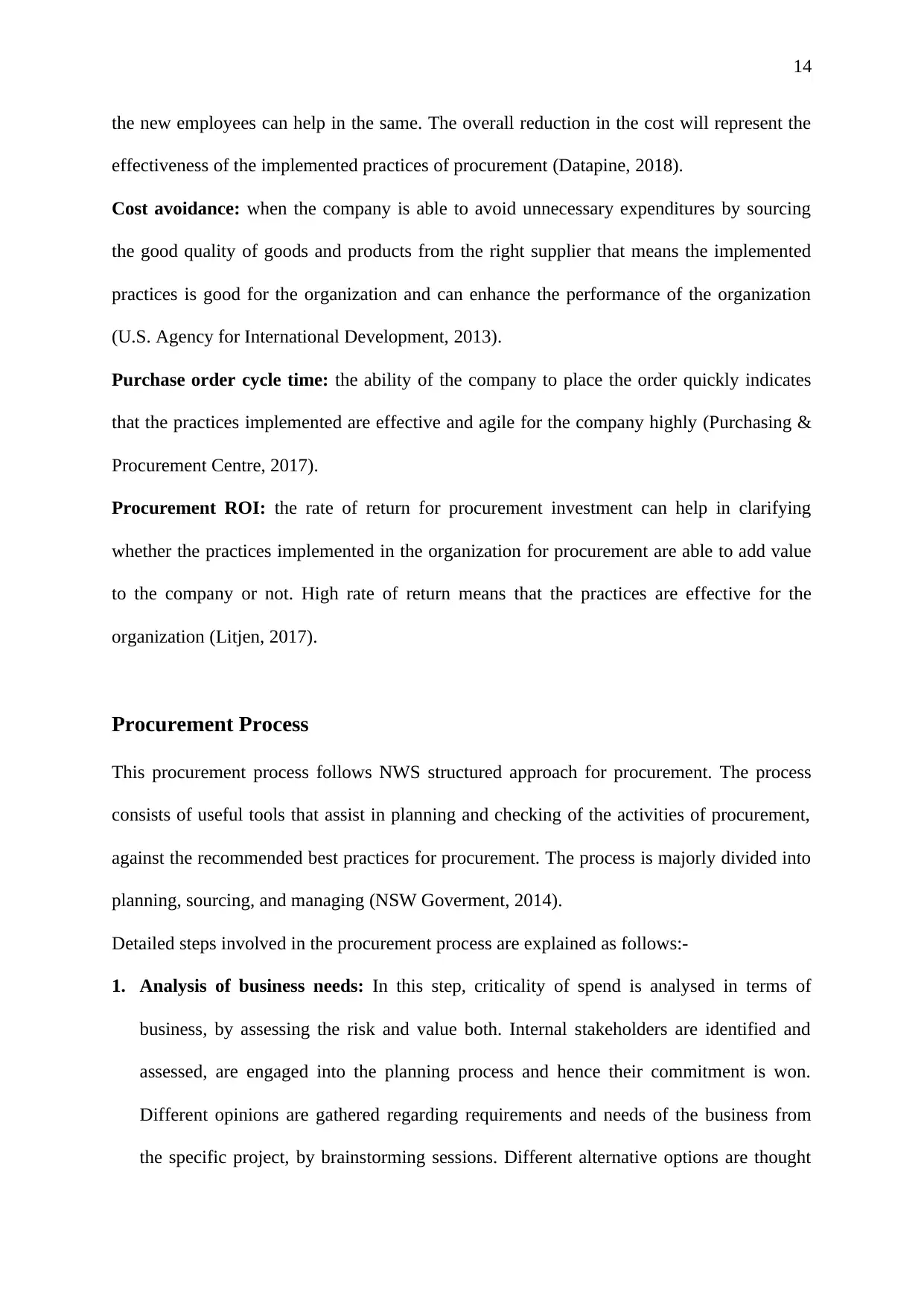
14
the new employees can help in the same. The overall reduction in the cost will represent the
effectiveness of the implemented practices of procurement (Datapine, 2018).
Cost avoidance: when the company is able to avoid unnecessary expenditures by sourcing
the good quality of goods and products from the right supplier that means the implemented
practices is good for the organization and can enhance the performance of the organization
(U.S. Agency for International Development, 2013).
Purchase order cycle time: the ability of the company to place the order quickly indicates
that the practices implemented are effective and agile for the company highly (Purchasing &
Procurement Centre, 2017).
Procurement ROI: the rate of return for procurement investment can help in clarifying
whether the practices implemented in the organization for procurement are able to add value
to the company or not. High rate of return means that the practices are effective for the
organization (Litjen, 2017).
Procurement Process
This procurement process follows NWS structured approach for procurement. The process
consists of useful tools that assist in planning and checking of the activities of procurement,
against the recommended best practices for procurement. The process is majorly divided into
planning, sourcing, and managing (NSW Goverment, 2014).
Detailed steps involved in the procurement process are explained as follows:-
1. Analysis of business needs: In this step, criticality of spend is analysed in terms of
business, by assessing the risk and value both. Internal stakeholders are identified and
assessed, are engaged into the planning process and hence their commitment is won.
Different opinions are gathered regarding requirements and needs of the business from
the specific project, by brainstorming sessions. Different alternative options are thought
the new employees can help in the same. The overall reduction in the cost will represent the
effectiveness of the implemented practices of procurement (Datapine, 2018).
Cost avoidance: when the company is able to avoid unnecessary expenditures by sourcing
the good quality of goods and products from the right supplier that means the implemented
practices is good for the organization and can enhance the performance of the organization
(U.S. Agency for International Development, 2013).
Purchase order cycle time: the ability of the company to place the order quickly indicates
that the practices implemented are effective and agile for the company highly (Purchasing &
Procurement Centre, 2017).
Procurement ROI: the rate of return for procurement investment can help in clarifying
whether the practices implemented in the organization for procurement are able to add value
to the company or not. High rate of return means that the practices are effective for the
organization (Litjen, 2017).
Procurement Process
This procurement process follows NWS structured approach for procurement. The process
consists of useful tools that assist in planning and checking of the activities of procurement,
against the recommended best practices for procurement. The process is majorly divided into
planning, sourcing, and managing (NSW Goverment, 2014).
Detailed steps involved in the procurement process are explained as follows:-
1. Analysis of business needs: In this step, criticality of spend is analysed in terms of
business, by assessing the risk and value both. Internal stakeholders are identified and
assessed, are engaged into the planning process and hence their commitment is won.
Different opinions are gathered regarding requirements and needs of the business from
the specific project, by brainstorming sessions. Different alternative options are thought
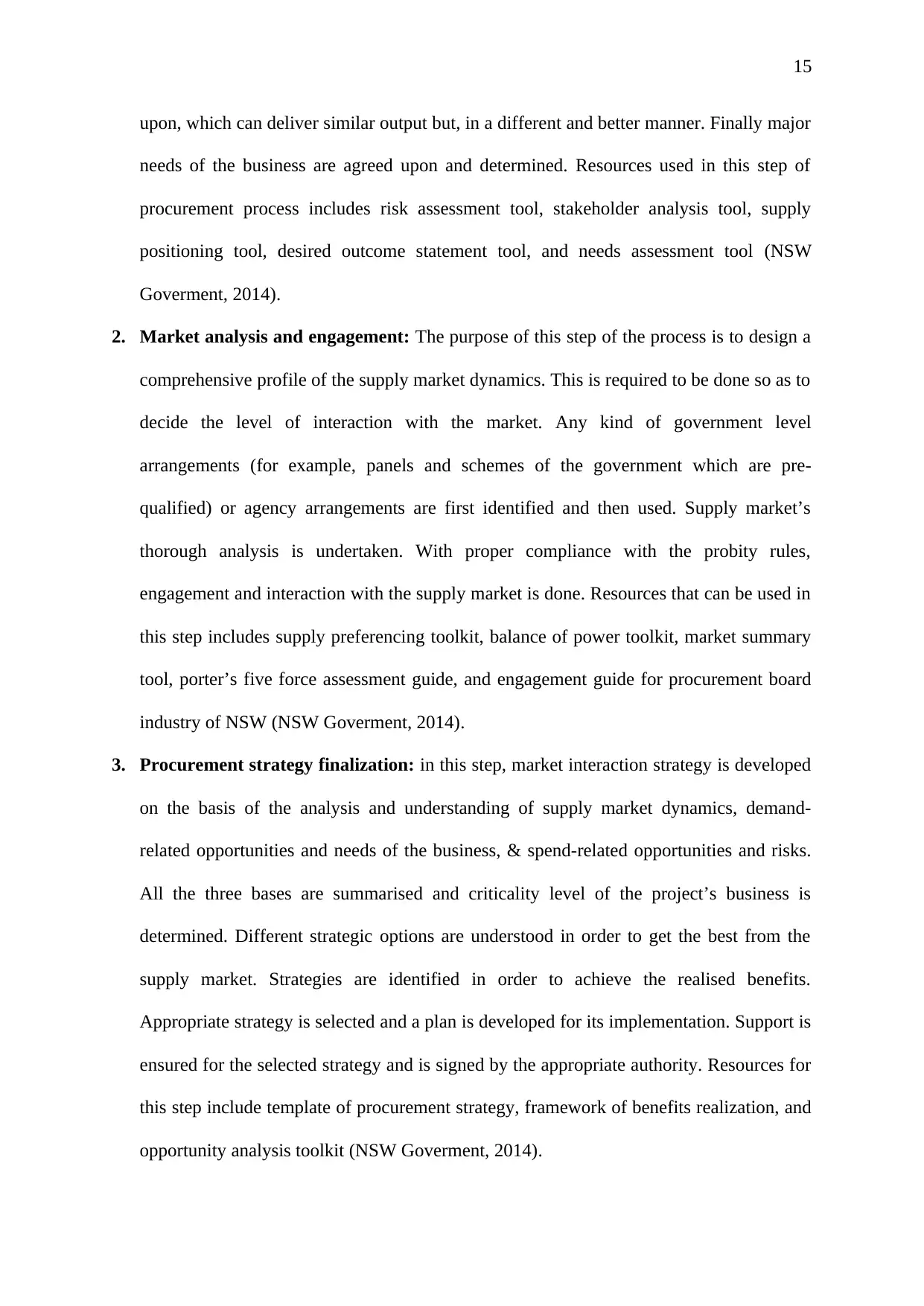
15
upon, which can deliver similar output but, in a different and better manner. Finally major
needs of the business are agreed upon and determined. Resources used in this step of
procurement process includes risk assessment tool, stakeholder analysis tool, supply
positioning tool, desired outcome statement tool, and needs assessment tool (NSW
Goverment, 2014).
2. Market analysis and engagement: The purpose of this step of the process is to design a
comprehensive profile of the supply market dynamics. This is required to be done so as to
decide the level of interaction with the market. Any kind of government level
arrangements (for example, panels and schemes of the government which are pre-
qualified) or agency arrangements are first identified and then used. Supply market’s
thorough analysis is undertaken. With proper compliance with the probity rules,
engagement and interaction with the supply market is done. Resources that can be used in
this step includes supply preferencing toolkit, balance of power toolkit, market summary
tool, porter’s five force assessment guide, and engagement guide for procurement board
industry of NSW (NSW Goverment, 2014).
3. Procurement strategy finalization: in this step, market interaction strategy is developed
on the basis of the analysis and understanding of supply market dynamics, demand-
related opportunities and needs of the business, & spend-related opportunities and risks.
All the three bases are summarised and criticality level of the project’s business is
determined. Different strategic options are understood in order to get the best from the
supply market. Strategies are identified in order to achieve the realised benefits.
Appropriate strategy is selected and a plan is developed for its implementation. Support is
ensured for the selected strategy and is signed by the appropriate authority. Resources for
this step include template of procurement strategy, framework of benefits realization, and
opportunity analysis toolkit (NSW Goverment, 2014).
upon, which can deliver similar output but, in a different and better manner. Finally major
needs of the business are agreed upon and determined. Resources used in this step of
procurement process includes risk assessment tool, stakeholder analysis tool, supply
positioning tool, desired outcome statement tool, and needs assessment tool (NSW
Goverment, 2014).
2. Market analysis and engagement: The purpose of this step of the process is to design a
comprehensive profile of the supply market dynamics. This is required to be done so as to
decide the level of interaction with the market. Any kind of government level
arrangements (for example, panels and schemes of the government which are pre-
qualified) or agency arrangements are first identified and then used. Supply market’s
thorough analysis is undertaken. With proper compliance with the probity rules,
engagement and interaction with the supply market is done. Resources that can be used in
this step includes supply preferencing toolkit, balance of power toolkit, market summary
tool, porter’s five force assessment guide, and engagement guide for procurement board
industry of NSW (NSW Goverment, 2014).
3. Procurement strategy finalization: in this step, market interaction strategy is developed
on the basis of the analysis and understanding of supply market dynamics, demand-
related opportunities and needs of the business, & spend-related opportunities and risks.
All the three bases are summarised and criticality level of the project’s business is
determined. Different strategic options are understood in order to get the best from the
supply market. Strategies are identified in order to achieve the realised benefits.
Appropriate strategy is selected and a plan is developed for its implementation. Support is
ensured for the selected strategy and is signed by the appropriate authority. Resources for
this step include template of procurement strategy, framework of benefits realization, and
opportunity analysis toolkit (NSW Goverment, 2014).
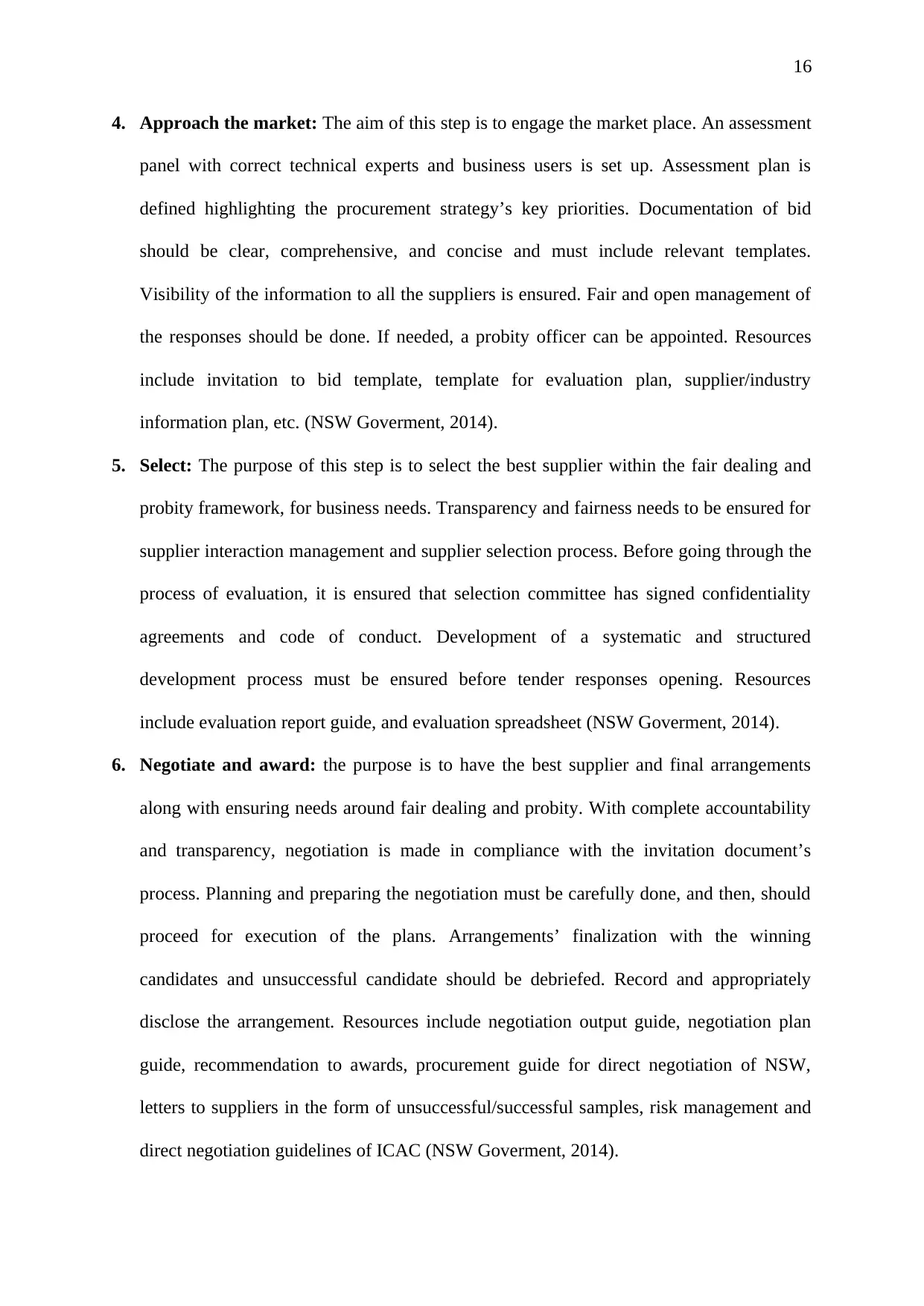
16
4. Approach the market: The aim of this step is to engage the market place. An assessment
panel with correct technical experts and business users is set up. Assessment plan is
defined highlighting the procurement strategy’s key priorities. Documentation of bid
should be clear, comprehensive, and concise and must include relevant templates.
Visibility of the information to all the suppliers is ensured. Fair and open management of
the responses should be done. If needed, a probity officer can be appointed. Resources
include invitation to bid template, template for evaluation plan, supplier/industry
information plan, etc. (NSW Goverment, 2014).
5. Select: The purpose of this step is to select the best supplier within the fair dealing and
probity framework, for business needs. Transparency and fairness needs to be ensured for
supplier interaction management and supplier selection process. Before going through the
process of evaluation, it is ensured that selection committee has signed confidentiality
agreements and code of conduct. Development of a systematic and structured
development process must be ensured before tender responses opening. Resources
include evaluation report guide, and evaluation spreadsheet (NSW Goverment, 2014).
6. Negotiate and award: the purpose is to have the best supplier and final arrangements
along with ensuring needs around fair dealing and probity. With complete accountability
and transparency, negotiation is made in compliance with the invitation document’s
process. Planning and preparing the negotiation must be carefully done, and then, should
proceed for execution of the plans. Arrangements’ finalization with the winning
candidates and unsuccessful candidate should be debriefed. Record and appropriately
disclose the arrangement. Resources include negotiation output guide, negotiation plan
guide, recommendation to awards, procurement guide for direct negotiation of NSW,
letters to suppliers in the form of unsuccessful/successful samples, risk management and
direct negotiation guidelines of ICAC (NSW Goverment, 2014).
4. Approach the market: The aim of this step is to engage the market place. An assessment
panel with correct technical experts and business users is set up. Assessment plan is
defined highlighting the procurement strategy’s key priorities. Documentation of bid
should be clear, comprehensive, and concise and must include relevant templates.
Visibility of the information to all the suppliers is ensured. Fair and open management of
the responses should be done. If needed, a probity officer can be appointed. Resources
include invitation to bid template, template for evaluation plan, supplier/industry
information plan, etc. (NSW Goverment, 2014).
5. Select: The purpose of this step is to select the best supplier within the fair dealing and
probity framework, for business needs. Transparency and fairness needs to be ensured for
supplier interaction management and supplier selection process. Before going through the
process of evaluation, it is ensured that selection committee has signed confidentiality
agreements and code of conduct. Development of a systematic and structured
development process must be ensured before tender responses opening. Resources
include evaluation report guide, and evaluation spreadsheet (NSW Goverment, 2014).
6. Negotiate and award: the purpose is to have the best supplier and final arrangements
along with ensuring needs around fair dealing and probity. With complete accountability
and transparency, negotiation is made in compliance with the invitation document’s
process. Planning and preparing the negotiation must be carefully done, and then, should
proceed for execution of the plans. Arrangements’ finalization with the winning
candidates and unsuccessful candidate should be debriefed. Record and appropriately
disclose the arrangement. Resources include negotiation output guide, negotiation plan
guide, recommendation to awards, procurement guide for direct negotiation of NSW,
letters to suppliers in the form of unsuccessful/successful samples, risk management and
direct negotiation guidelines of ICAC (NSW Goverment, 2014).
Secure Best Marks with AI Grader
Need help grading? Try our AI Grader for instant feedback on your assignments.
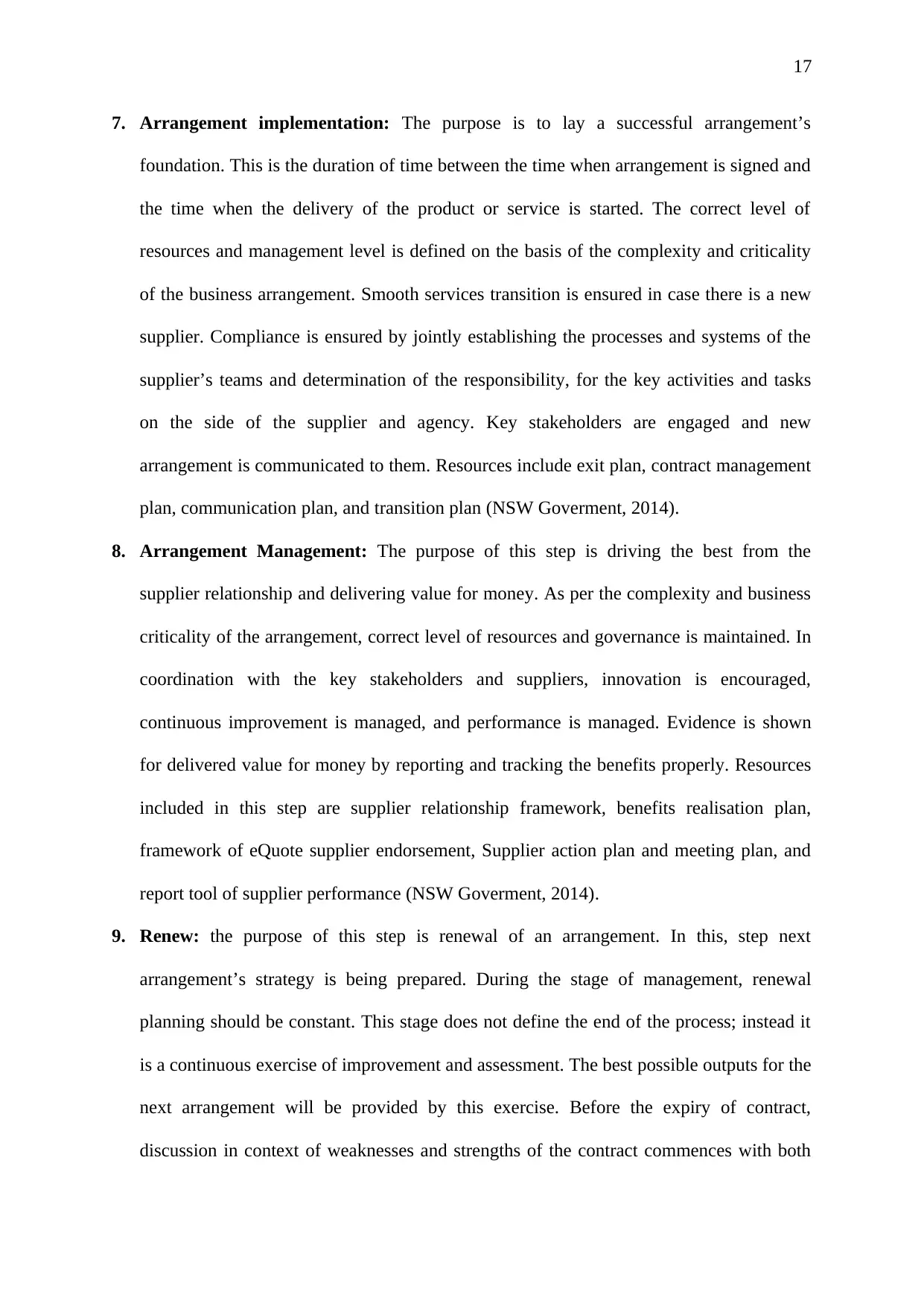
17
7. Arrangement implementation: The purpose is to lay a successful arrangement’s
foundation. This is the duration of time between the time when arrangement is signed and
the time when the delivery of the product or service is started. The correct level of
resources and management level is defined on the basis of the complexity and criticality
of the business arrangement. Smooth services transition is ensured in case there is a new
supplier. Compliance is ensured by jointly establishing the processes and systems of the
supplier’s teams and determination of the responsibility, for the key activities and tasks
on the side of the supplier and agency. Key stakeholders are engaged and new
arrangement is communicated to them. Resources include exit plan, contract management
plan, communication plan, and transition plan (NSW Goverment, 2014).
8. Arrangement Management: The purpose of this step is driving the best from the
supplier relationship and delivering value for money. As per the complexity and business
criticality of the arrangement, correct level of resources and governance is maintained. In
coordination with the key stakeholders and suppliers, innovation is encouraged,
continuous improvement is managed, and performance is managed. Evidence is shown
for delivered value for money by reporting and tracking the benefits properly. Resources
included in this step are supplier relationship framework, benefits realisation plan,
framework of eQuote supplier endorsement, Supplier action plan and meeting plan, and
report tool of supplier performance (NSW Goverment, 2014).
9. Renew: the purpose of this step is renewal of an arrangement. In this, step next
arrangement’s strategy is being prepared. During the stage of management, renewal
planning should be constant. This stage does not define the end of the process; instead it
is a continuous exercise of improvement and assessment. The best possible outputs for the
next arrangement will be provided by this exercise. Before the expiry of contract,
discussion in context of weaknesses and strengths of the contract commences with both
7. Arrangement implementation: The purpose is to lay a successful arrangement’s
foundation. This is the duration of time between the time when arrangement is signed and
the time when the delivery of the product or service is started. The correct level of
resources and management level is defined on the basis of the complexity and criticality
of the business arrangement. Smooth services transition is ensured in case there is a new
supplier. Compliance is ensured by jointly establishing the processes and systems of the
supplier’s teams and determination of the responsibility, for the key activities and tasks
on the side of the supplier and agency. Key stakeholders are engaged and new
arrangement is communicated to them. Resources include exit plan, contract management
plan, communication plan, and transition plan (NSW Goverment, 2014).
8. Arrangement Management: The purpose of this step is driving the best from the
supplier relationship and delivering value for money. As per the complexity and business
criticality of the arrangement, correct level of resources and governance is maintained. In
coordination with the key stakeholders and suppliers, innovation is encouraged,
continuous improvement is managed, and performance is managed. Evidence is shown
for delivered value for money by reporting and tracking the benefits properly. Resources
included in this step are supplier relationship framework, benefits realisation plan,
framework of eQuote supplier endorsement, Supplier action plan and meeting plan, and
report tool of supplier performance (NSW Goverment, 2014).
9. Renew: the purpose of this step is renewal of an arrangement. In this, step next
arrangement’s strategy is being prepared. During the stage of management, renewal
planning should be constant. This stage does not define the end of the process; instead it
is a continuous exercise of improvement and assessment. The best possible outputs for the
next arrangement will be provided by this exercise. Before the expiry of contract,
discussion in context of weaknesses and strengths of the contract commences with both
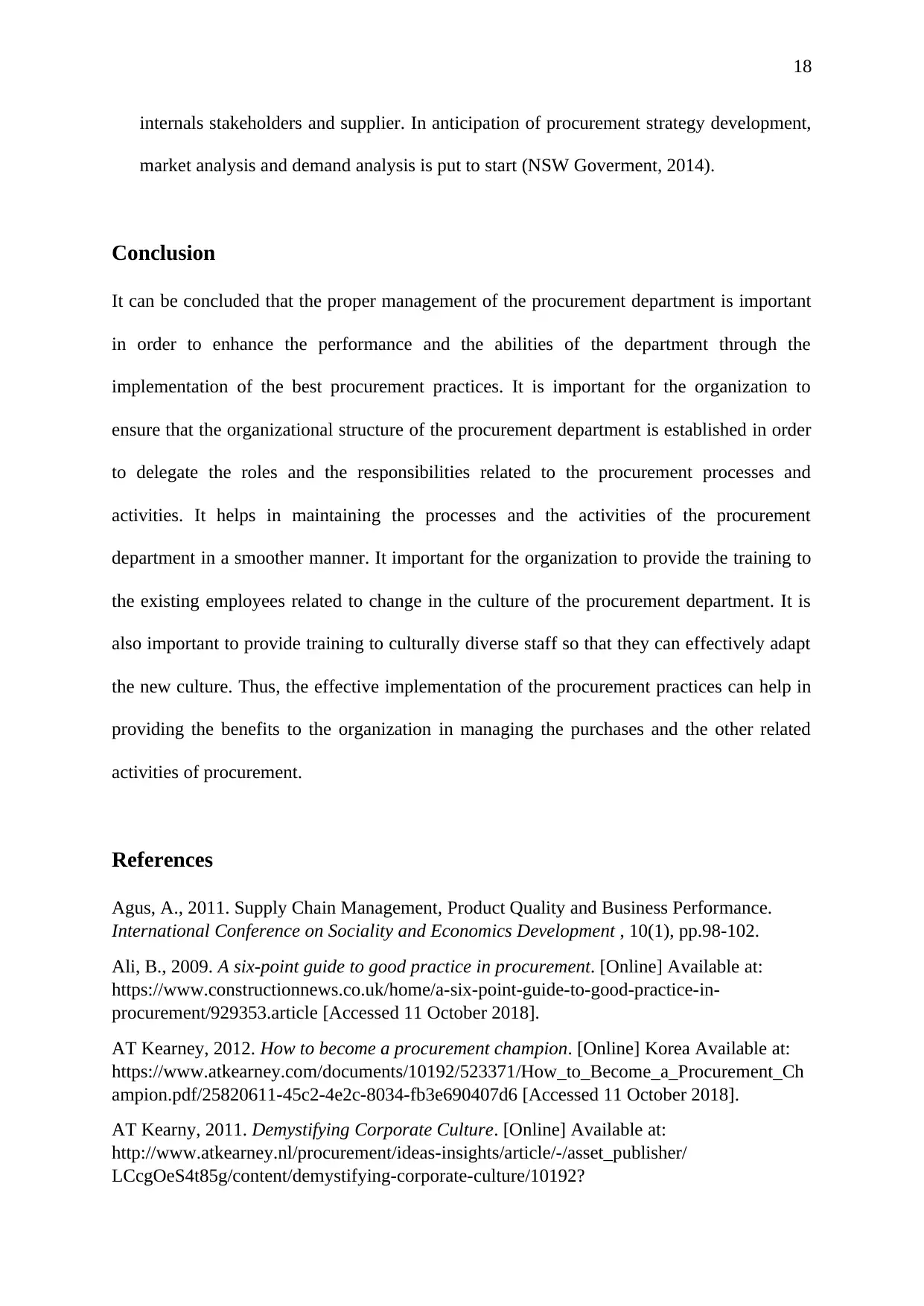
18
internals stakeholders and supplier. In anticipation of procurement strategy development,
market analysis and demand analysis is put to start (NSW Goverment, 2014).
Conclusion
It can be concluded that the proper management of the procurement department is important
in order to enhance the performance and the abilities of the department through the
implementation of the best procurement practices. It is important for the organization to
ensure that the organizational structure of the procurement department is established in order
to delegate the roles and the responsibilities related to the procurement processes and
activities. It helps in maintaining the processes and the activities of the procurement
department in a smoother manner. It important for the organization to provide the training to
the existing employees related to change in the culture of the procurement department. It is
also important to provide training to culturally diverse staff so that they can effectively adapt
the new culture. Thus, the effective implementation of the procurement practices can help in
providing the benefits to the organization in managing the purchases and the other related
activities of procurement.
References
Agus, A., 2011. Supply Chain Management, Product Quality and Business Performance.
International Conference on Sociality and Economics Development , 10(1), pp.98-102.
Ali, B., 2009. A six-point guide to good practice in procurement. [Online] Available at:
https://www.constructionnews.co.uk/home/a-six-point-guide-to-good-practice-in-
procurement/929353.article [Accessed 11 October 2018].
AT Kearney, 2012. How to become a procurement champion. [Online] Korea Available at:
https://www.atkearney.com/documents/10192/523371/How_to_Become_a_Procurement_Ch
ampion.pdf/25820611-45c2-4e2c-8034-fb3e690407d6 [Accessed 11 October 2018].
AT Kearny, 2011. Demystifying Corporate Culture. [Online] Available at:
http://www.atkearney.nl/procurement/ideas-insights/article/-/asset_publisher/
LCcgOeS4t85g/content/demystifying-corporate-culture/10192?
internals stakeholders and supplier. In anticipation of procurement strategy development,
market analysis and demand analysis is put to start (NSW Goverment, 2014).
Conclusion
It can be concluded that the proper management of the procurement department is important
in order to enhance the performance and the abilities of the department through the
implementation of the best procurement practices. It is important for the organization to
ensure that the organizational structure of the procurement department is established in order
to delegate the roles and the responsibilities related to the procurement processes and
activities. It helps in maintaining the processes and the activities of the procurement
department in a smoother manner. It important for the organization to provide the training to
the existing employees related to change in the culture of the procurement department. It is
also important to provide training to culturally diverse staff so that they can effectively adapt
the new culture. Thus, the effective implementation of the procurement practices can help in
providing the benefits to the organization in managing the purchases and the other related
activities of procurement.
References
Agus, A., 2011. Supply Chain Management, Product Quality and Business Performance.
International Conference on Sociality and Economics Development , 10(1), pp.98-102.
Ali, B., 2009. A six-point guide to good practice in procurement. [Online] Available at:
https://www.constructionnews.co.uk/home/a-six-point-guide-to-good-practice-in-
procurement/929353.article [Accessed 11 October 2018].
AT Kearney, 2012. How to become a procurement champion. [Online] Korea Available at:
https://www.atkearney.com/documents/10192/523371/How_to_Become_a_Procurement_Ch
ampion.pdf/25820611-45c2-4e2c-8034-fb3e690407d6 [Accessed 11 October 2018].
AT Kearny, 2011. Demystifying Corporate Culture. [Online] Available at:
http://www.atkearney.nl/procurement/ideas-insights/article/-/asset_publisher/
LCcgOeS4t85g/content/demystifying-corporate-culture/10192?
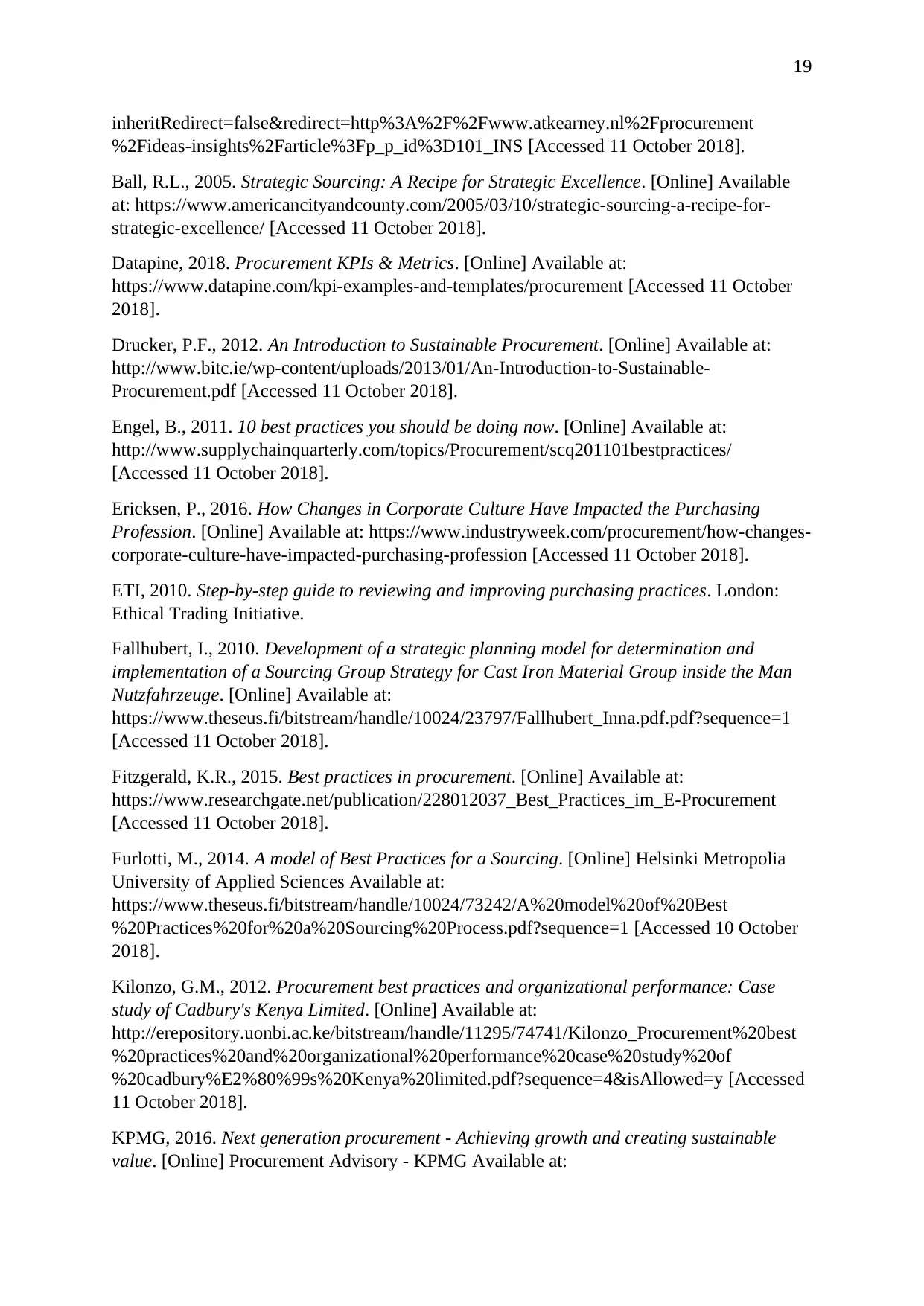
19
inheritRedirect=false&redirect=http%3A%2F%2Fwww.atkearney.nl%2Fprocurement
%2Fideas-insights%2Farticle%3Fp_p_id%3D101_INS [Accessed 11 October 2018].
Ball, R.L., 2005. Strategic Sourcing: A Recipe for Strategic Excellence. [Online] Available
at: https://www.americancityandcounty.com/2005/03/10/strategic-sourcing-a-recipe-for-
strategic-excellence/ [Accessed 11 October 2018].
Datapine, 2018. Procurement KPIs & Metrics. [Online] Available at:
https://www.datapine.com/kpi-examples-and-templates/procurement [Accessed 11 October
2018].
Drucker, P.F., 2012. An Introduction to Sustainable Procurement. [Online] Available at:
http://www.bitc.ie/wp-content/uploads/2013/01/An-Introduction-to-Sustainable-
Procurement.pdf [Accessed 11 October 2018].
Engel, B., 2011. 10 best practices you should be doing now. [Online] Available at:
http://www.supplychainquarterly.com/topics/Procurement/scq201101bestpractices/
[Accessed 11 October 2018].
Ericksen, P., 2016. How Changes in Corporate Culture Have Impacted the Purchasing
Profession. [Online] Available at: https://www.industryweek.com/procurement/how-changes-
corporate-culture-have-impacted-purchasing-profession [Accessed 11 October 2018].
ETI, 2010. Step-by-step guide to reviewing and improving purchasing practices. London:
Ethical Trading Initiative.
Fallhubert, I., 2010. Development of a strategic planning model for determination and
implementation of a Sourcing Group Strategy for Cast Iron Material Group inside the Man
Nutzfahrzeuge. [Online] Available at:
https://www.theseus.fi/bitstream/handle/10024/23797/Fallhubert_Inna.pdf.pdf?sequence=1
[Accessed 11 October 2018].
Fitzgerald, K.R., 2015. Best practices in procurement. [Online] Available at:
https://www.researchgate.net/publication/228012037_Best_Practices_im_E-Procurement
[Accessed 11 October 2018].
Furlotti, M., 2014. A model of Best Practices for a Sourcing. [Online] Helsinki Metropolia
University of Applied Sciences Available at:
https://www.theseus.fi/bitstream/handle/10024/73242/A%20model%20of%20Best
%20Practices%20for%20a%20Sourcing%20Process.pdf?sequence=1 [Accessed 10 October
2018].
Kilonzo, G.M., 2012. Procurement best practices and organizational performance: Case
study of Cadbury's Kenya Limited. [Online] Available at:
http://erepository.uonbi.ac.ke/bitstream/handle/11295/74741/Kilonzo_Procurement%20best
%20practices%20and%20organizational%20performance%20case%20study%20of
%20cadbury%E2%80%99s%20Kenya%20limited.pdf?sequence=4&isAllowed=y [Accessed
11 October 2018].
KPMG, 2016. Next generation procurement - Achieving growth and creating sustainable
value. [Online] Procurement Advisory - KPMG Available at:
inheritRedirect=false&redirect=http%3A%2F%2Fwww.atkearney.nl%2Fprocurement
%2Fideas-insights%2Farticle%3Fp_p_id%3D101_INS [Accessed 11 October 2018].
Ball, R.L., 2005. Strategic Sourcing: A Recipe for Strategic Excellence. [Online] Available
at: https://www.americancityandcounty.com/2005/03/10/strategic-sourcing-a-recipe-for-
strategic-excellence/ [Accessed 11 October 2018].
Datapine, 2018. Procurement KPIs & Metrics. [Online] Available at:
https://www.datapine.com/kpi-examples-and-templates/procurement [Accessed 11 October
2018].
Drucker, P.F., 2012. An Introduction to Sustainable Procurement. [Online] Available at:
http://www.bitc.ie/wp-content/uploads/2013/01/An-Introduction-to-Sustainable-
Procurement.pdf [Accessed 11 October 2018].
Engel, B., 2011. 10 best practices you should be doing now. [Online] Available at:
http://www.supplychainquarterly.com/topics/Procurement/scq201101bestpractices/
[Accessed 11 October 2018].
Ericksen, P., 2016. How Changes in Corporate Culture Have Impacted the Purchasing
Profession. [Online] Available at: https://www.industryweek.com/procurement/how-changes-
corporate-culture-have-impacted-purchasing-profession [Accessed 11 October 2018].
ETI, 2010. Step-by-step guide to reviewing and improving purchasing practices. London:
Ethical Trading Initiative.
Fallhubert, I., 2010. Development of a strategic planning model for determination and
implementation of a Sourcing Group Strategy for Cast Iron Material Group inside the Man
Nutzfahrzeuge. [Online] Available at:
https://www.theseus.fi/bitstream/handle/10024/23797/Fallhubert_Inna.pdf.pdf?sequence=1
[Accessed 11 October 2018].
Fitzgerald, K.R., 2015. Best practices in procurement. [Online] Available at:
https://www.researchgate.net/publication/228012037_Best_Practices_im_E-Procurement
[Accessed 11 October 2018].
Furlotti, M., 2014. A model of Best Practices for a Sourcing. [Online] Helsinki Metropolia
University of Applied Sciences Available at:
https://www.theseus.fi/bitstream/handle/10024/73242/A%20model%20of%20Best
%20Practices%20for%20a%20Sourcing%20Process.pdf?sequence=1 [Accessed 10 October
2018].
Kilonzo, G.M., 2012. Procurement best practices and organizational performance: Case
study of Cadbury's Kenya Limited. [Online] Available at:
http://erepository.uonbi.ac.ke/bitstream/handle/11295/74741/Kilonzo_Procurement%20best
%20practices%20and%20organizational%20performance%20case%20study%20of
%20cadbury%E2%80%99s%20Kenya%20limited.pdf?sequence=4&isAllowed=y [Accessed
11 October 2018].
KPMG, 2016. Next generation procurement - Achieving growth and creating sustainable
value. [Online] Procurement Advisory - KPMG Available at:
Paraphrase This Document
Need a fresh take? Get an instant paraphrase of this document with our AI Paraphraser
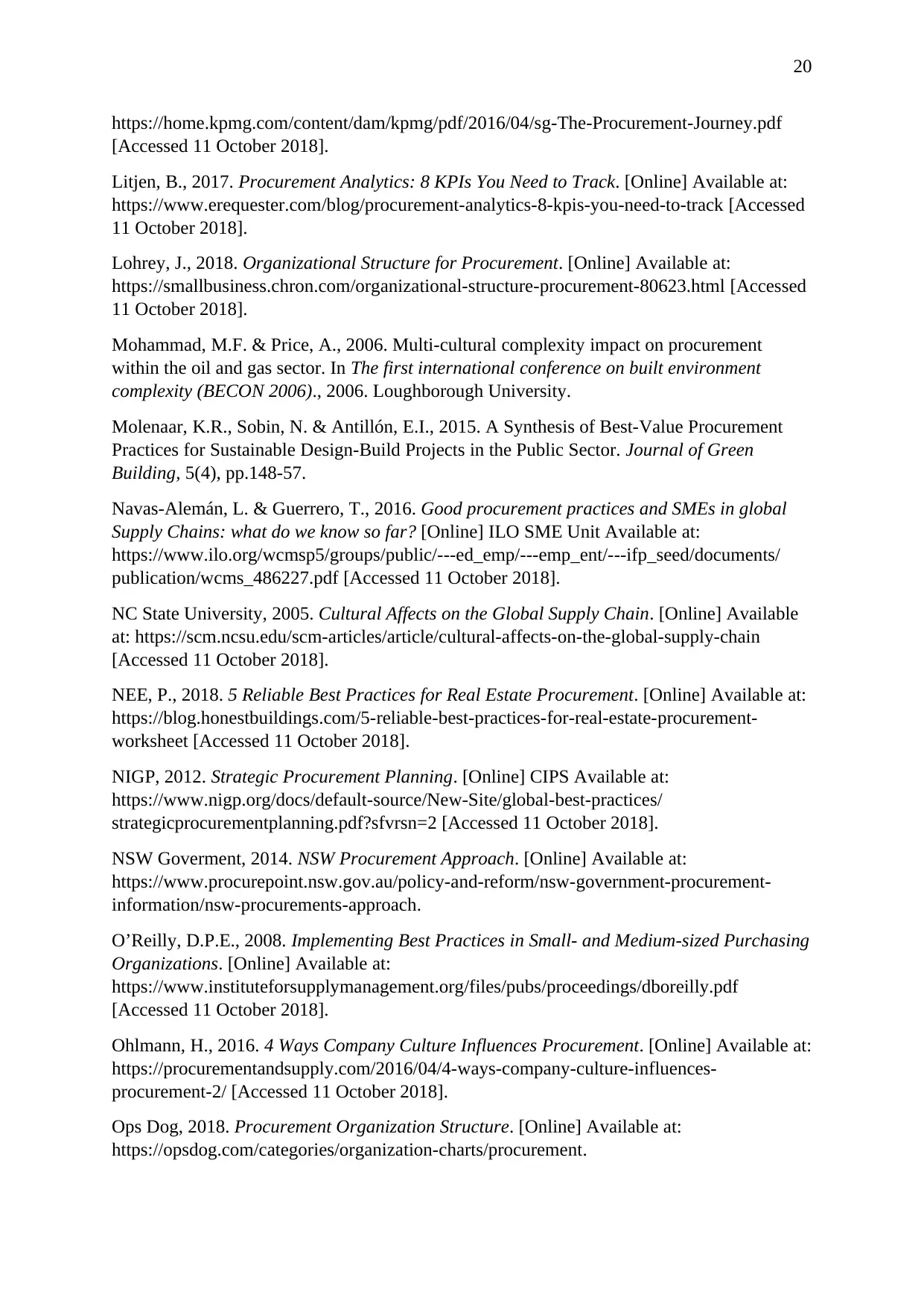
20
https://home.kpmg.com/content/dam/kpmg/pdf/2016/04/sg-The-Procurement-Journey.pdf
[Accessed 11 October 2018].
Litjen, B., 2017. Procurement Analytics: 8 KPIs You Need to Track. [Online] Available at:
https://www.erequester.com/blog/procurement-analytics-8-kpis-you-need-to-track [Accessed
11 October 2018].
Lohrey, J., 2018. Organizational Structure for Procurement. [Online] Available at:
https://smallbusiness.chron.com/organizational-structure-procurement-80623.html [Accessed
11 October 2018].
Mohammad, M.F. & Price, A., 2006. Multi-cultural complexity impact on procurement
within the oil and gas sector. In The first international conference on built environment
complexity (BECON 2006)., 2006. Loughborough University.
Molenaar, K.R., Sobin, N. & Antillón, E.I., 2015. A Synthesis of Best-Value Procurement
Practices for Sustainable Design-Build Projects in the Public Sector. Journal of Green
Building, 5(4), pp.148-57.
Navas-Alemán, L. & Guerrero, T., 2016. Good procurement practices and SMEs in global
Supply Chains: what do we know so far? [Online] ILO SME Unit Available at:
https://www.ilo.org/wcmsp5/groups/public/---ed_emp/---emp_ent/---ifp_seed/documents/
publication/wcms_486227.pdf [Accessed 11 October 2018].
NC State University, 2005. Cultural Affects on the Global Supply Chain. [Online] Available
at: https://scm.ncsu.edu/scm-articles/article/cultural-affects-on-the-global-supply-chain
[Accessed 11 October 2018].
NEE, P., 2018. 5 Reliable Best Practices for Real Estate Procurement. [Online] Available at:
https://blog.honestbuildings.com/5-reliable-best-practices-for-real-estate-procurement-
worksheet [Accessed 11 October 2018].
NIGP, 2012. Strategic Procurement Planning. [Online] CIPS Available at:
https://www.nigp.org/docs/default-source/New-Site/global-best-practices/
strategicprocurementplanning.pdf?sfvrsn=2 [Accessed 11 October 2018].
NSW Goverment, 2014. NSW Procurement Approach. [Online] Available at:
https://www.procurepoint.nsw.gov.au/policy-and-reform/nsw-government-procurement-
information/nsw-procurements-approach.
O’Reilly, D.P.E., 2008. Implementing Best Practices in Small- and Medium-sized Purchasing
Organizations. [Online] Available at:
https://www.instituteforsupplymanagement.org/files/pubs/proceedings/dboreilly.pdf
[Accessed 11 October 2018].
Ohlmann, H., 2016. 4 Ways Company Culture Influences Procurement. [Online] Available at:
https://procurementandsupply.com/2016/04/4-ways-company-culture-influences-
procurement-2/ [Accessed 11 October 2018].
Ops Dog, 2018. Procurement Organization Structure. [Online] Available at:
https://opsdog.com/categories/organization-charts/procurement.
https://home.kpmg.com/content/dam/kpmg/pdf/2016/04/sg-The-Procurement-Journey.pdf
[Accessed 11 October 2018].
Litjen, B., 2017. Procurement Analytics: 8 KPIs You Need to Track. [Online] Available at:
https://www.erequester.com/blog/procurement-analytics-8-kpis-you-need-to-track [Accessed
11 October 2018].
Lohrey, J., 2018. Organizational Structure for Procurement. [Online] Available at:
https://smallbusiness.chron.com/organizational-structure-procurement-80623.html [Accessed
11 October 2018].
Mohammad, M.F. & Price, A., 2006. Multi-cultural complexity impact on procurement
within the oil and gas sector. In The first international conference on built environment
complexity (BECON 2006)., 2006. Loughborough University.
Molenaar, K.R., Sobin, N. & Antillón, E.I., 2015. A Synthesis of Best-Value Procurement
Practices for Sustainable Design-Build Projects in the Public Sector. Journal of Green
Building, 5(4), pp.148-57.
Navas-Alemán, L. & Guerrero, T., 2016. Good procurement practices and SMEs in global
Supply Chains: what do we know so far? [Online] ILO SME Unit Available at:
https://www.ilo.org/wcmsp5/groups/public/---ed_emp/---emp_ent/---ifp_seed/documents/
publication/wcms_486227.pdf [Accessed 11 October 2018].
NC State University, 2005. Cultural Affects on the Global Supply Chain. [Online] Available
at: https://scm.ncsu.edu/scm-articles/article/cultural-affects-on-the-global-supply-chain
[Accessed 11 October 2018].
NEE, P., 2018. 5 Reliable Best Practices for Real Estate Procurement. [Online] Available at:
https://blog.honestbuildings.com/5-reliable-best-practices-for-real-estate-procurement-
worksheet [Accessed 11 October 2018].
NIGP, 2012. Strategic Procurement Planning. [Online] CIPS Available at:
https://www.nigp.org/docs/default-source/New-Site/global-best-practices/
strategicprocurementplanning.pdf?sfvrsn=2 [Accessed 11 October 2018].
NSW Goverment, 2014. NSW Procurement Approach. [Online] Available at:
https://www.procurepoint.nsw.gov.au/policy-and-reform/nsw-government-procurement-
information/nsw-procurements-approach.
O’Reilly, D.P.E., 2008. Implementing Best Practices in Small- and Medium-sized Purchasing
Organizations. [Online] Available at:
https://www.instituteforsupplymanagement.org/files/pubs/proceedings/dboreilly.pdf
[Accessed 11 October 2018].
Ohlmann, H., 2016. 4 Ways Company Culture Influences Procurement. [Online] Available at:
https://procurementandsupply.com/2016/04/4-ways-company-culture-influences-
procurement-2/ [Accessed 11 October 2018].
Ops Dog, 2018. Procurement Organization Structure. [Online] Available at:
https://opsdog.com/categories/organization-charts/procurement.
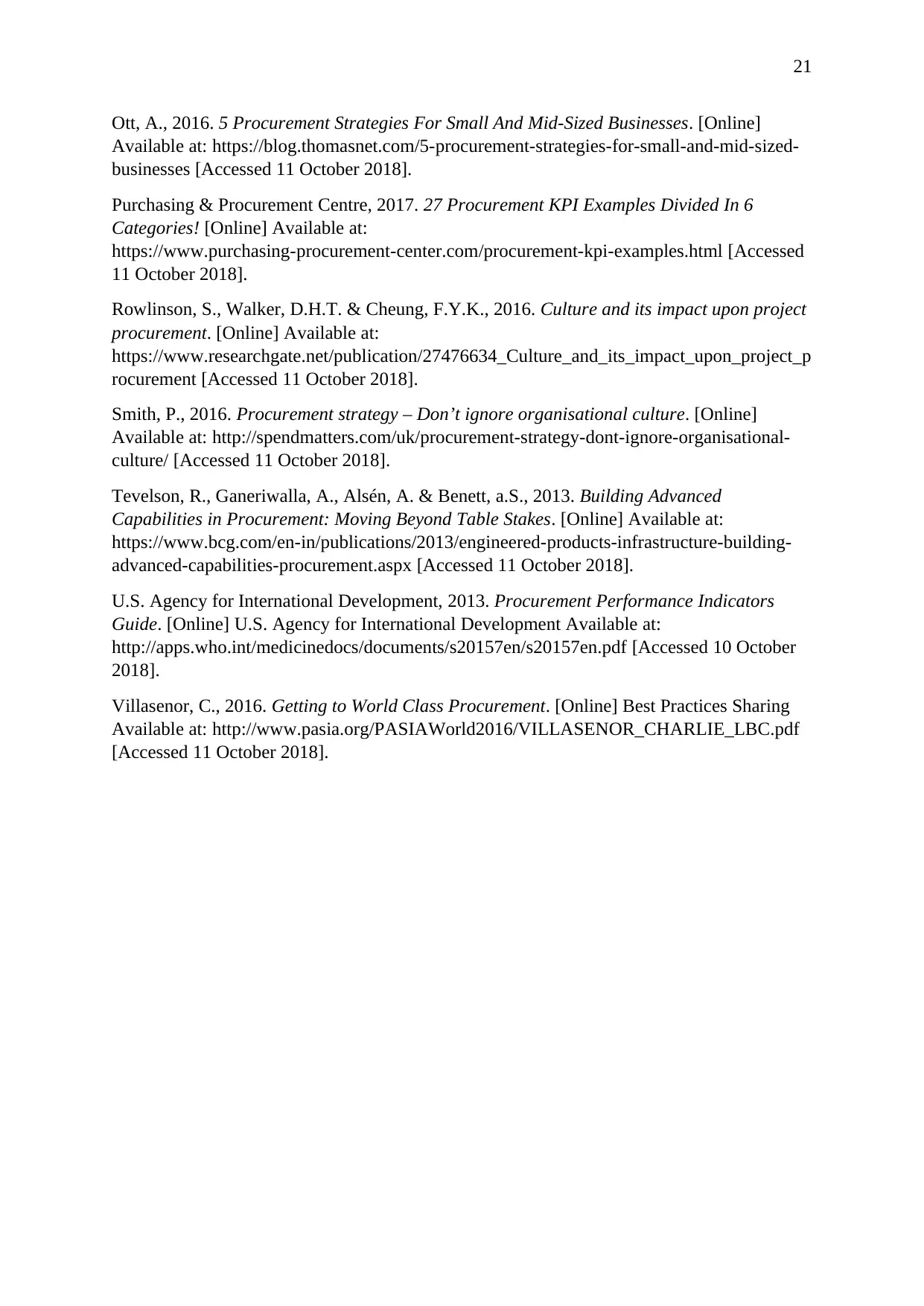
21
Ott, A., 2016. 5 Procurement Strategies For Small And Mid-Sized Businesses. [Online]
Available at: https://blog.thomasnet.com/5-procurement-strategies-for-small-and-mid-sized-
businesses [Accessed 11 October 2018].
Purchasing & Procurement Centre, 2017. 27 Procurement KPI Examples Divided In 6
Categories! [Online] Available at:
https://www.purchasing-procurement-center.com/procurement-kpi-examples.html [Accessed
11 October 2018].
Rowlinson, S., Walker, D.H.T. & Cheung, F.Y.K., 2016. Culture and its impact upon project
procurement. [Online] Available at:
https://www.researchgate.net/publication/27476634_Culture_and_its_impact_upon_project_p
rocurement [Accessed 11 October 2018].
Smith, P., 2016. Procurement strategy – Don’t ignore organisational culture. [Online]
Available at: http://spendmatters.com/uk/procurement-strategy-dont-ignore-organisational-
culture/ [Accessed 11 October 2018].
Tevelson, R., Ganeriwalla, A., Alsén, A. & Benett, a.S., 2013. Building Advanced
Capabilities in Procurement: Moving Beyond Table Stakes. [Online] Available at:
https://www.bcg.com/en-in/publications/2013/engineered-products-infrastructure-building-
advanced-capabilities-procurement.aspx [Accessed 11 October 2018].
U.S. Agency for International Development, 2013. Procurement Performance Indicators
Guide. [Online] U.S. Agency for International Development Available at:
http://apps.who.int/medicinedocs/documents/s20157en/s20157en.pdf [Accessed 10 October
2018].
Villasenor, C., 2016. Getting to World Class Procurement. [Online] Best Practices Sharing
Available at: http://www.pasia.org/PASIAWorld2016/VILLASENOR_CHARLIE_LBC.pdf
[Accessed 11 October 2018].
Ott, A., 2016. 5 Procurement Strategies For Small And Mid-Sized Businesses. [Online]
Available at: https://blog.thomasnet.com/5-procurement-strategies-for-small-and-mid-sized-
businesses [Accessed 11 October 2018].
Purchasing & Procurement Centre, 2017. 27 Procurement KPI Examples Divided In 6
Categories! [Online] Available at:
https://www.purchasing-procurement-center.com/procurement-kpi-examples.html [Accessed
11 October 2018].
Rowlinson, S., Walker, D.H.T. & Cheung, F.Y.K., 2016. Culture and its impact upon project
procurement. [Online] Available at:
https://www.researchgate.net/publication/27476634_Culture_and_its_impact_upon_project_p
rocurement [Accessed 11 October 2018].
Smith, P., 2016. Procurement strategy – Don’t ignore organisational culture. [Online]
Available at: http://spendmatters.com/uk/procurement-strategy-dont-ignore-organisational-
culture/ [Accessed 11 October 2018].
Tevelson, R., Ganeriwalla, A., Alsén, A. & Benett, a.S., 2013. Building Advanced
Capabilities in Procurement: Moving Beyond Table Stakes. [Online] Available at:
https://www.bcg.com/en-in/publications/2013/engineered-products-infrastructure-building-
advanced-capabilities-procurement.aspx [Accessed 11 October 2018].
U.S. Agency for International Development, 2013. Procurement Performance Indicators
Guide. [Online] U.S. Agency for International Development Available at:
http://apps.who.int/medicinedocs/documents/s20157en/s20157en.pdf [Accessed 10 October
2018].
Villasenor, C., 2016. Getting to World Class Procurement. [Online] Best Practices Sharing
Available at: http://www.pasia.org/PASIAWorld2016/VILLASENOR_CHARLIE_LBC.pdf
[Accessed 11 October 2018].
1 out of 21
Related Documents
Your All-in-One AI-Powered Toolkit for Academic Success.
+13062052269
info@desklib.com
Available 24*7 on WhatsApp / Email
![[object Object]](/_next/static/media/star-bottom.7253800d.svg)
Unlock your academic potential
© 2024 | Zucol Services PVT LTD | All rights reserved.





